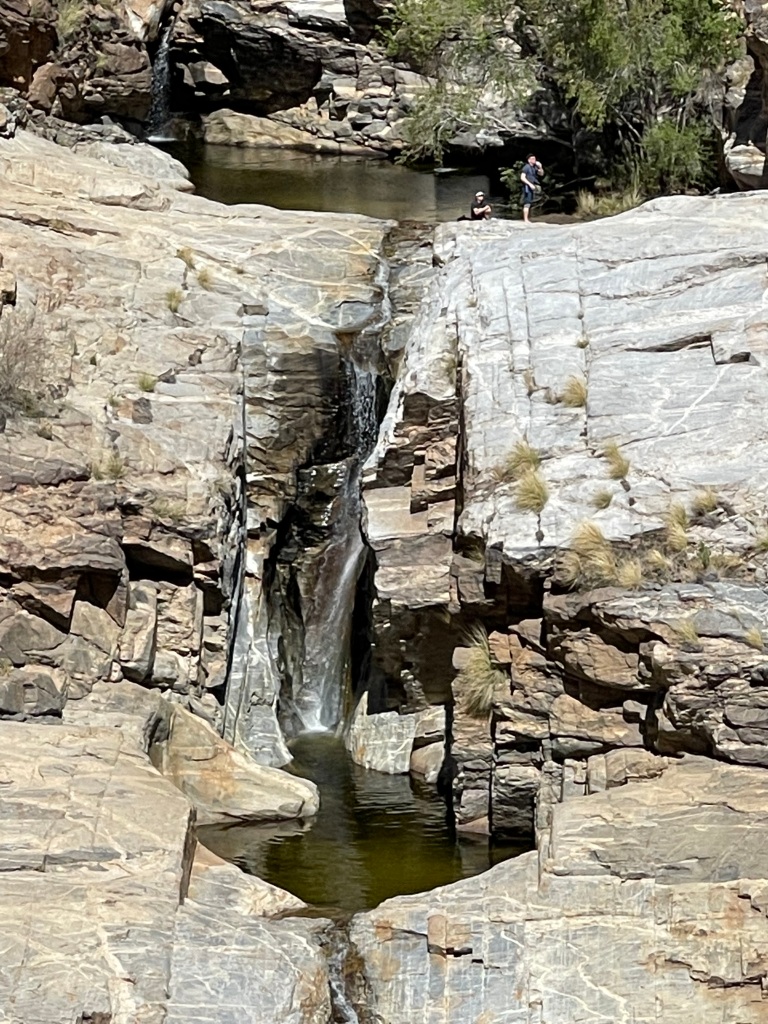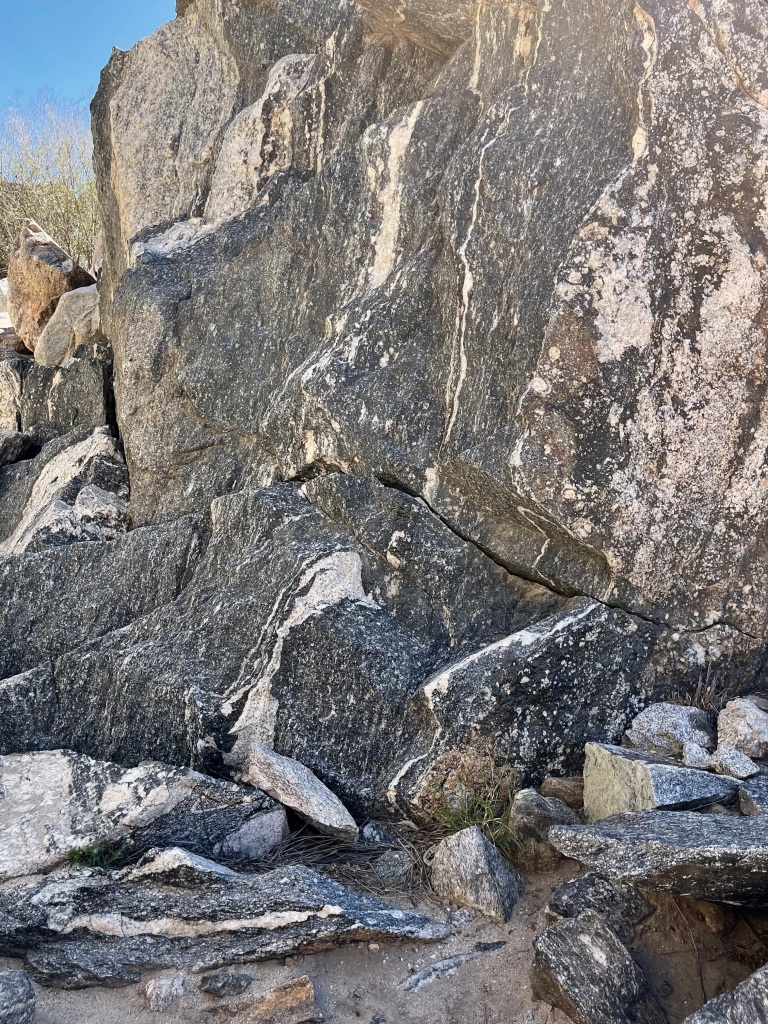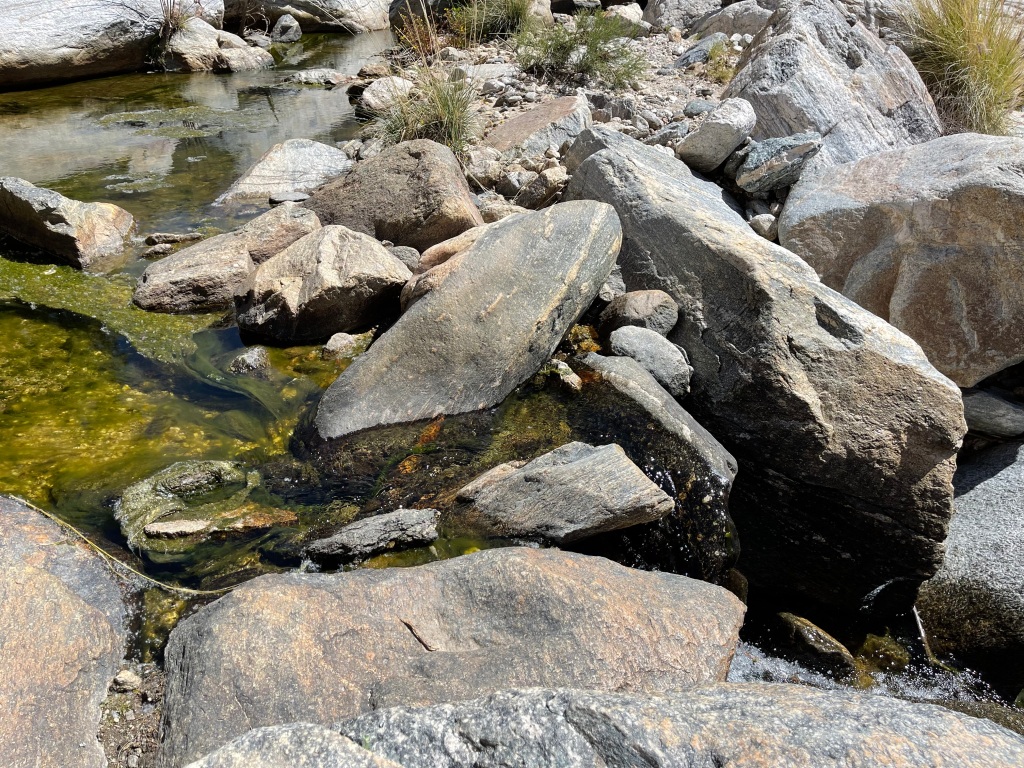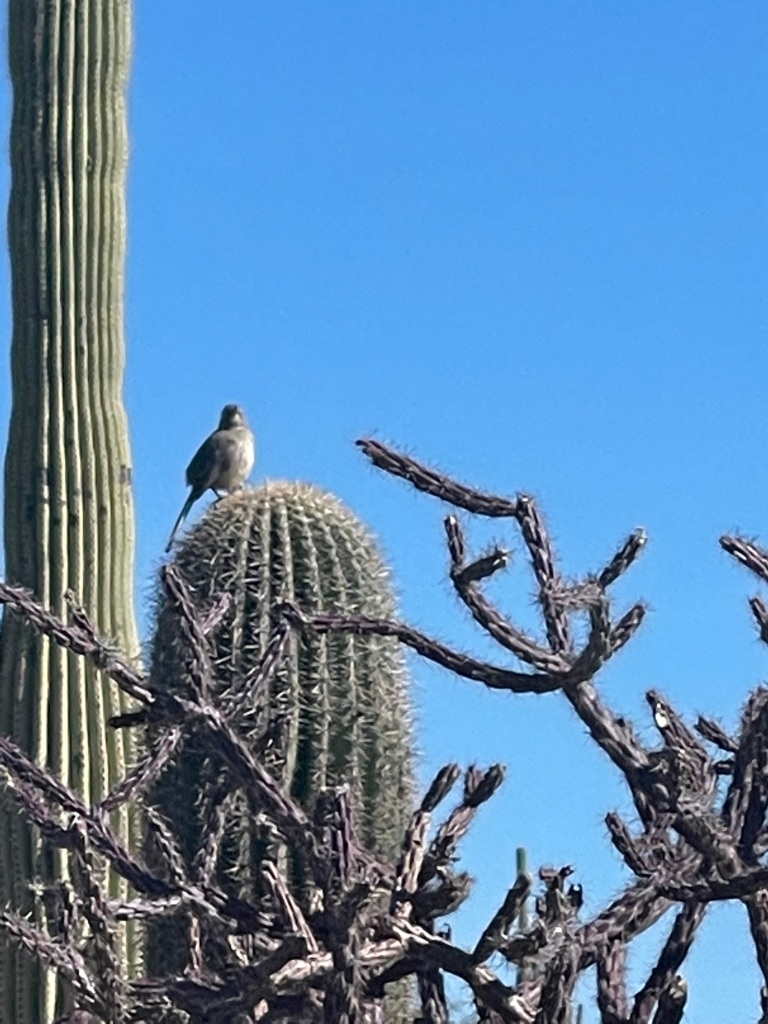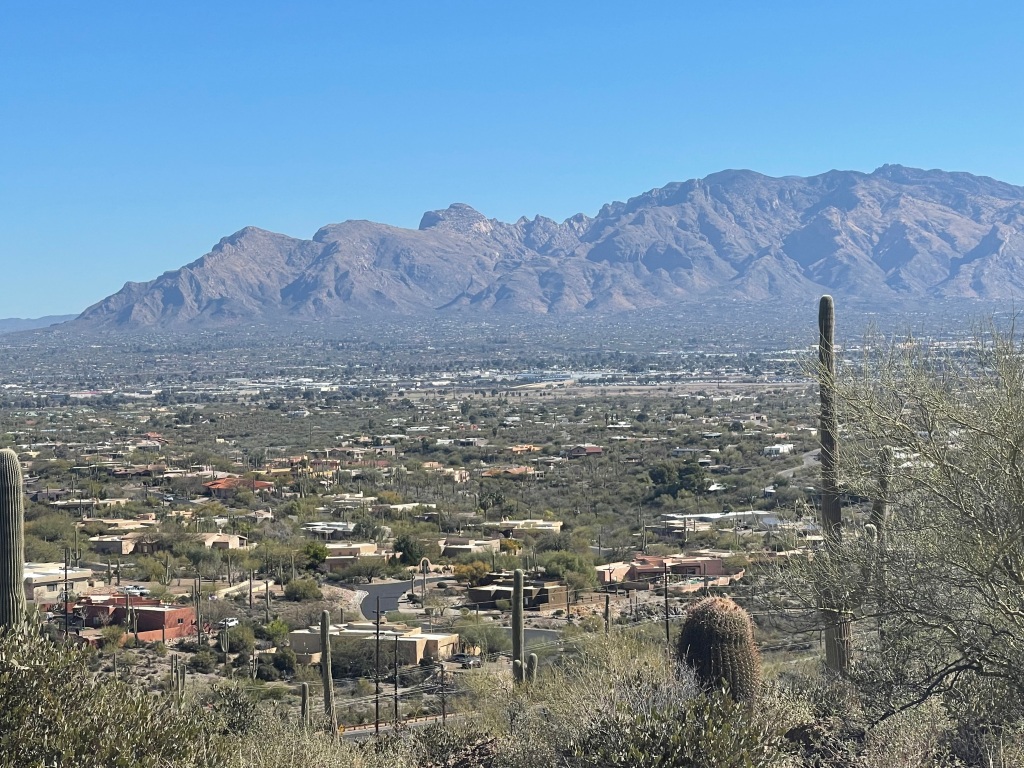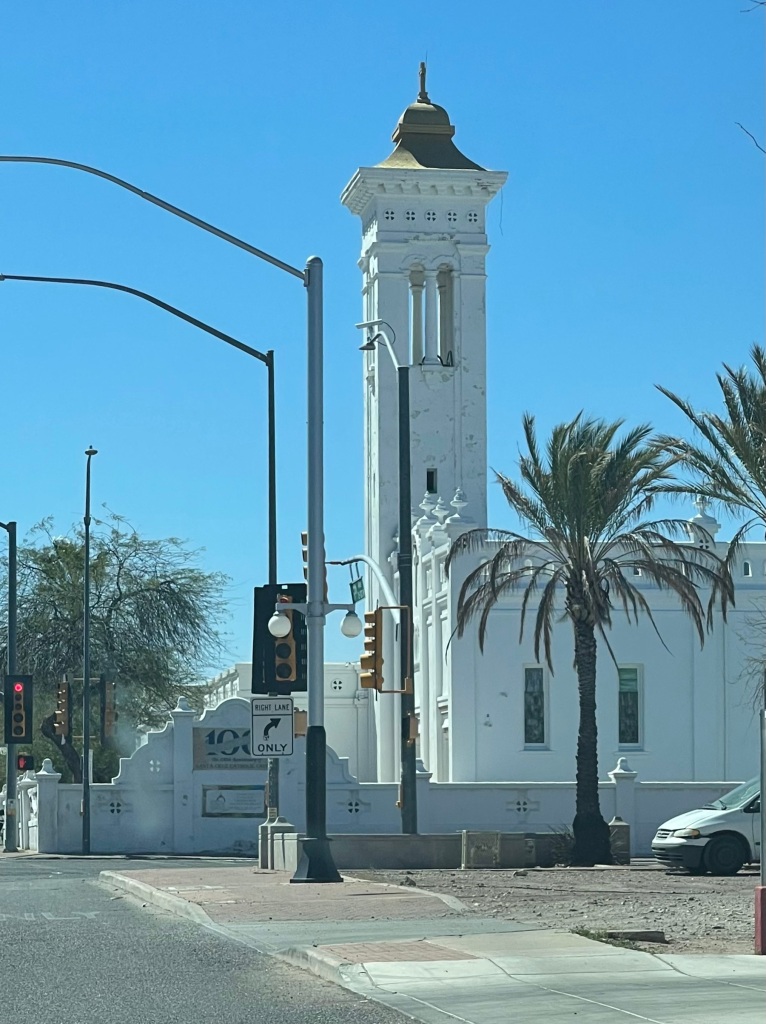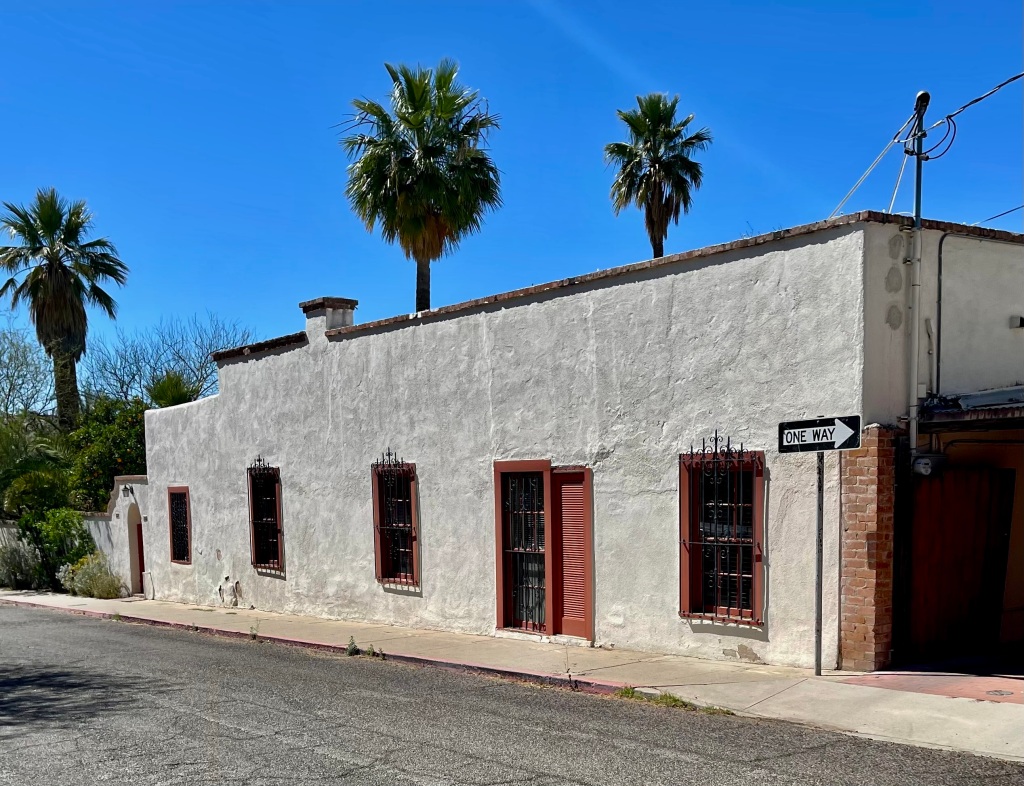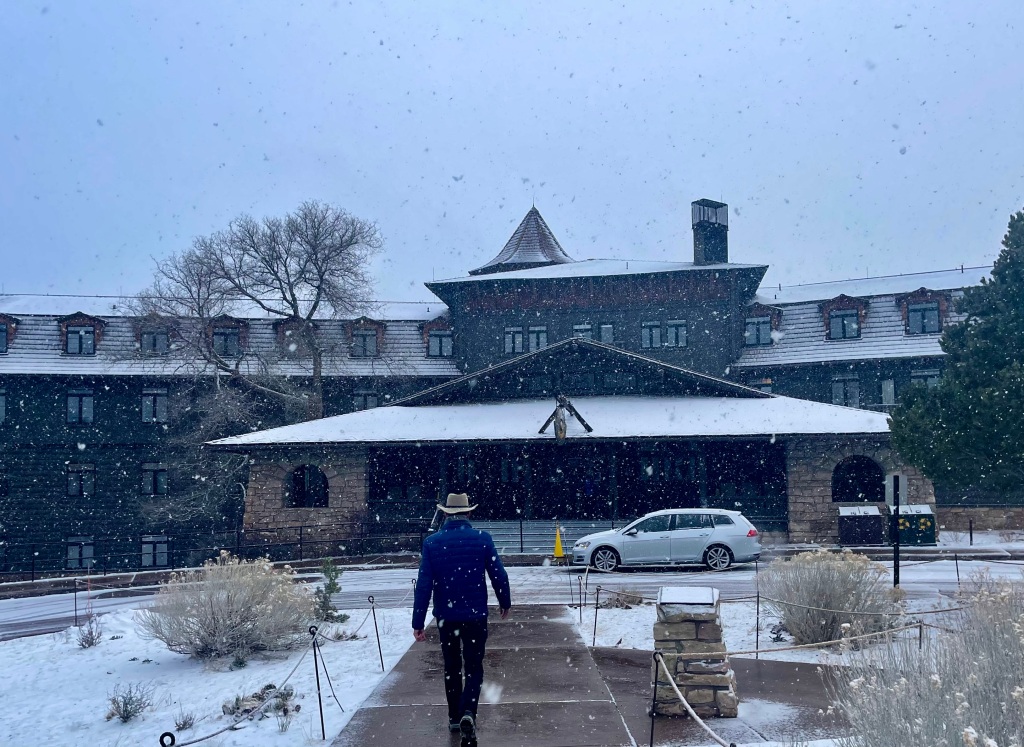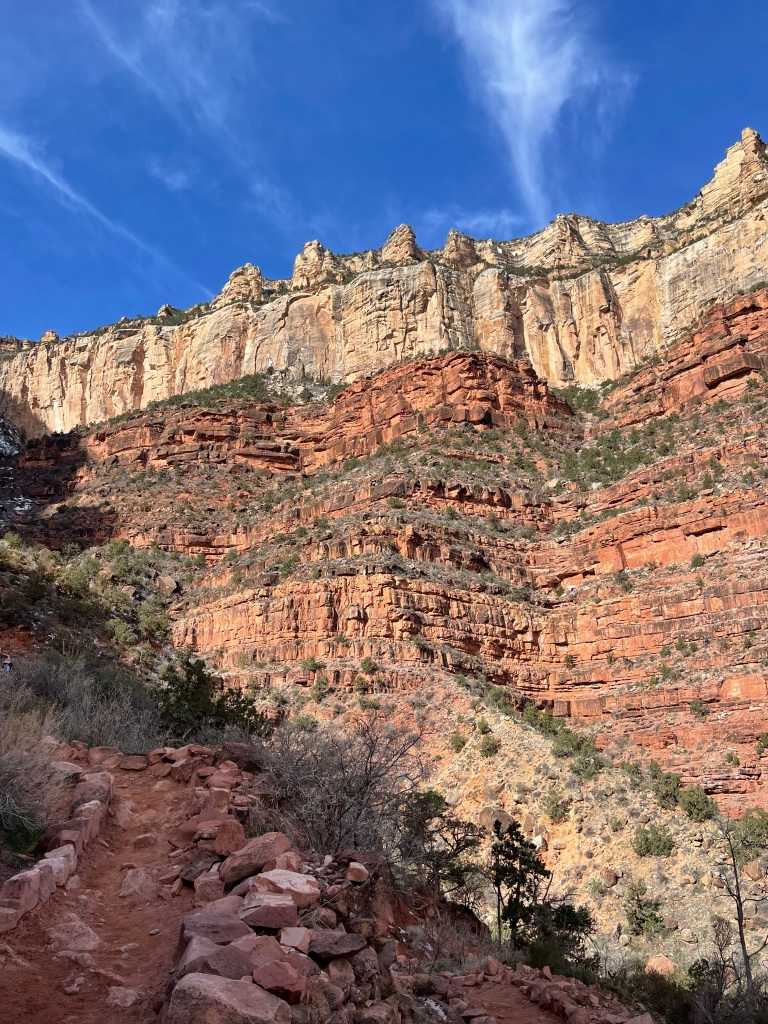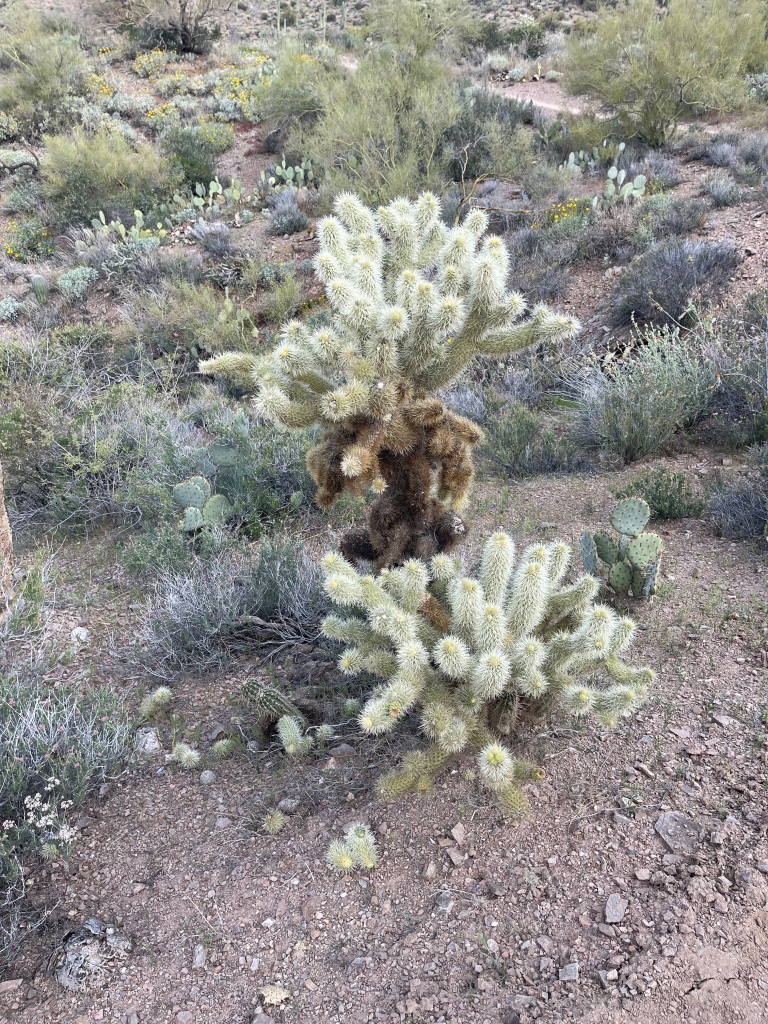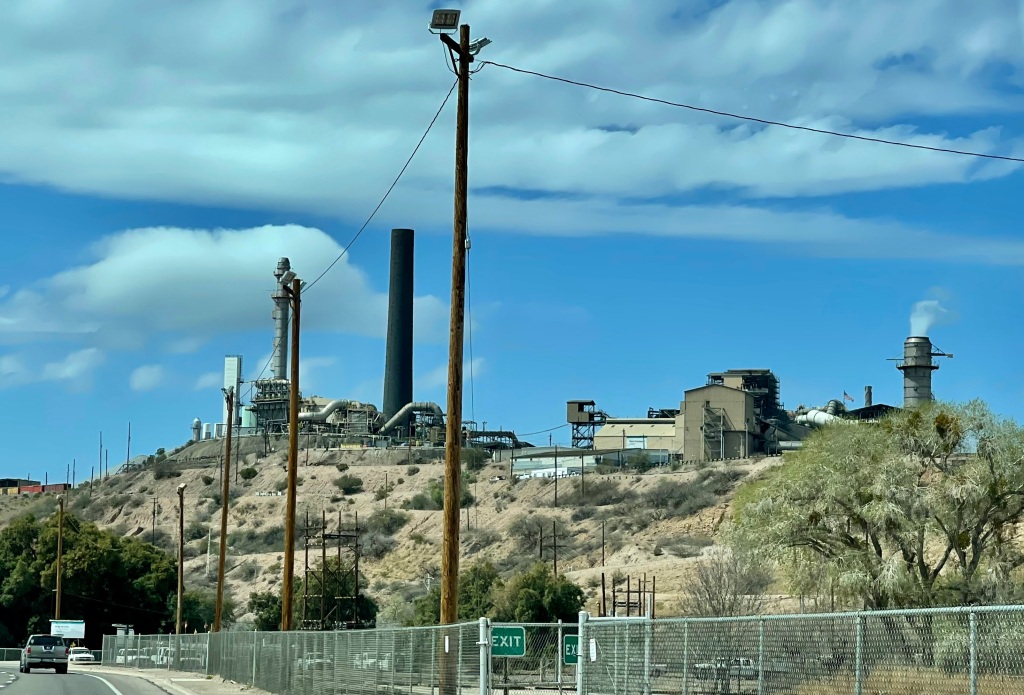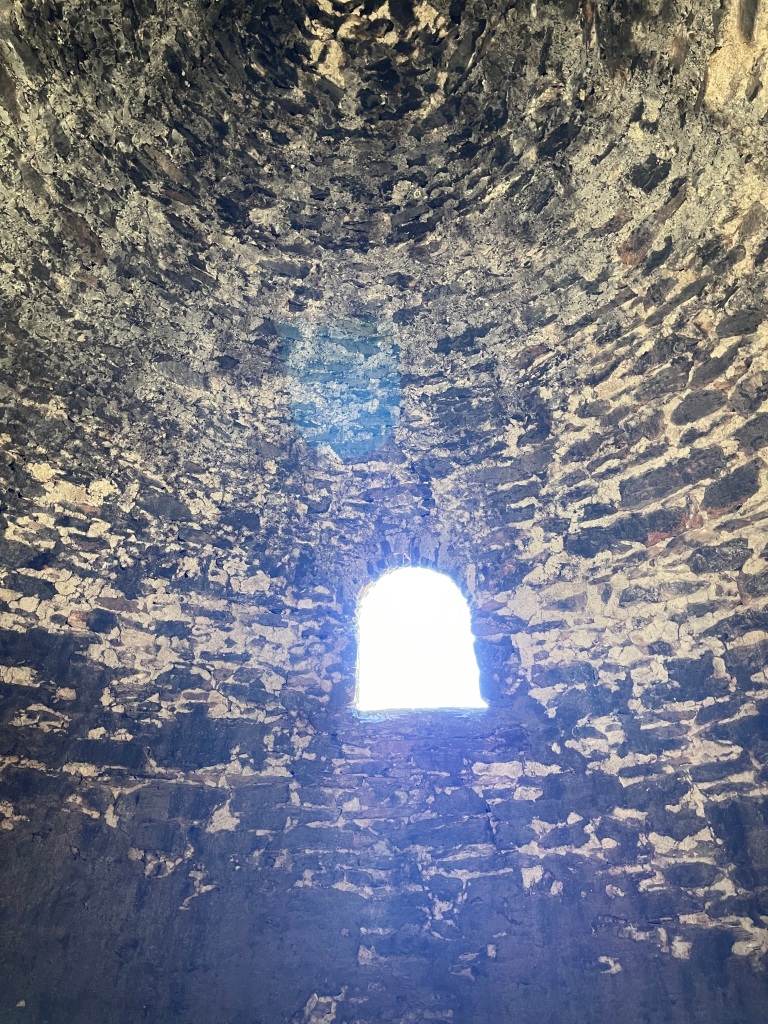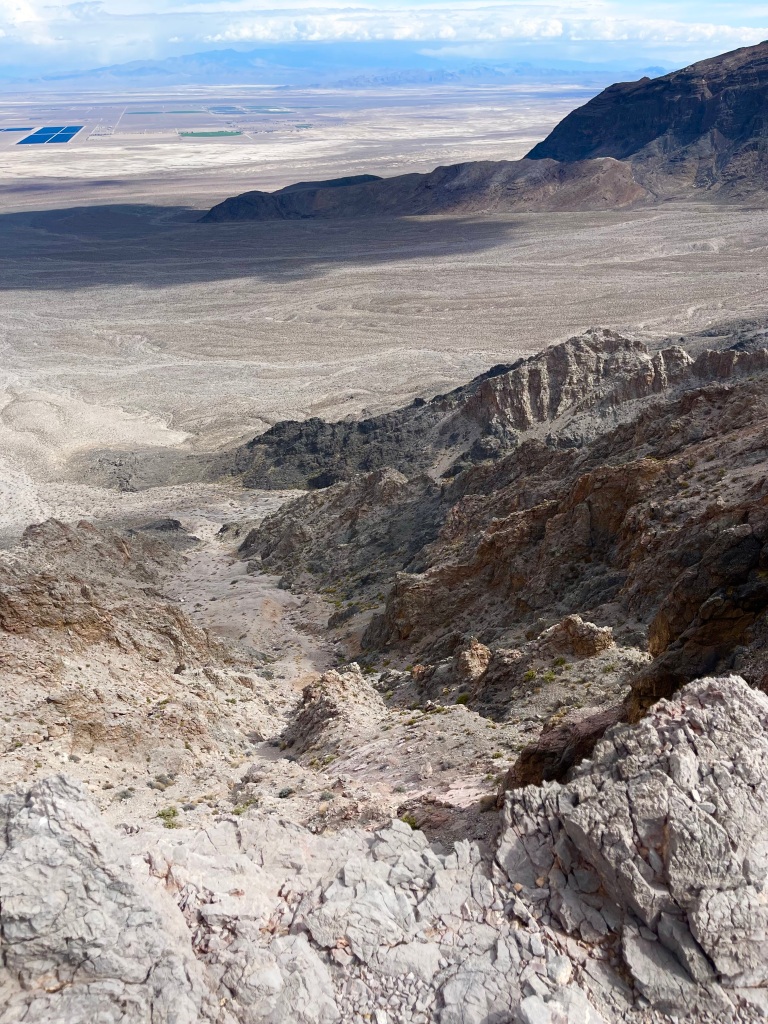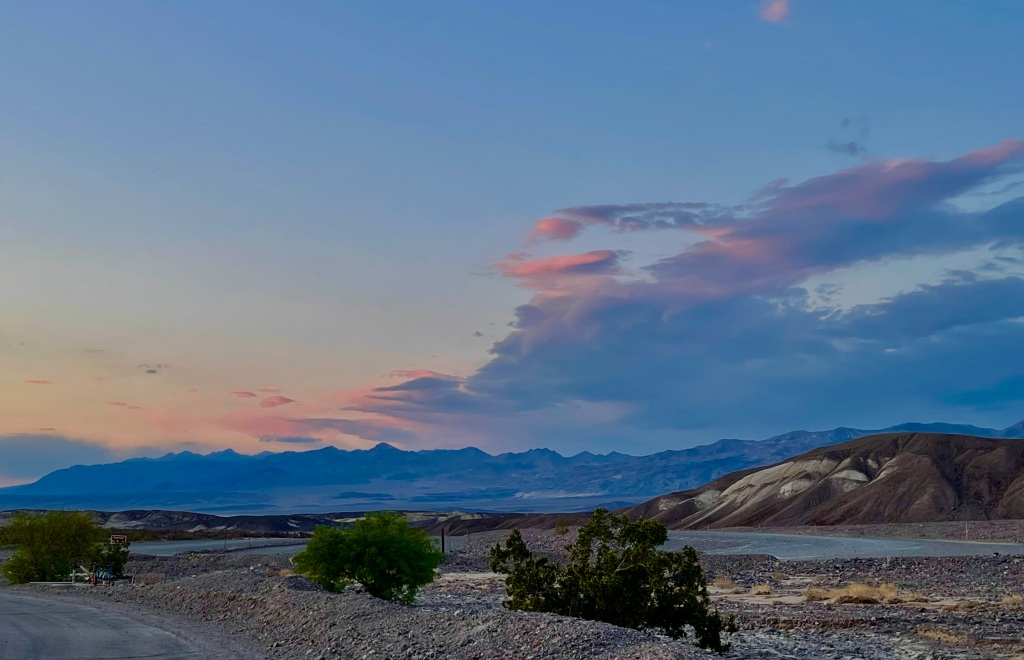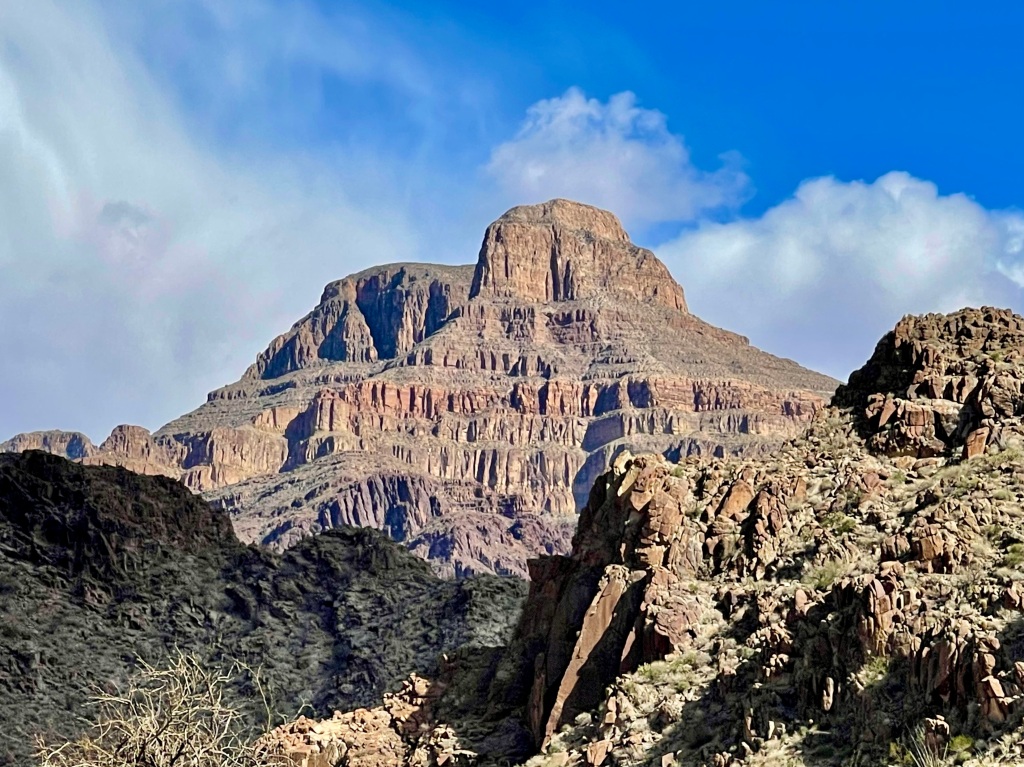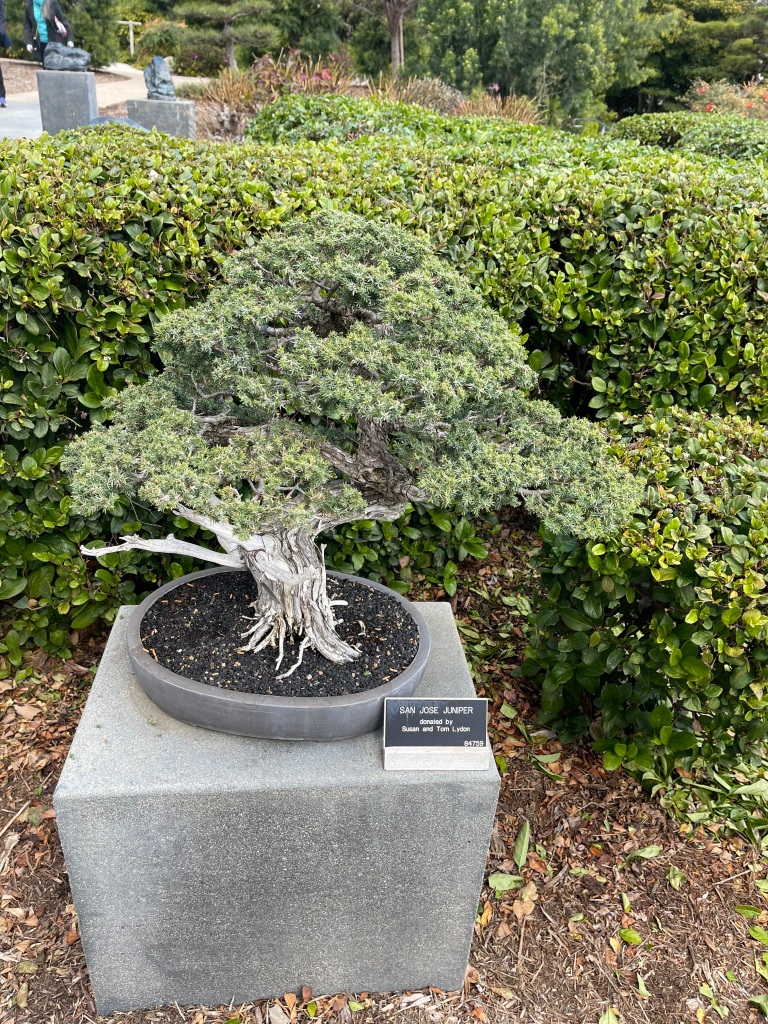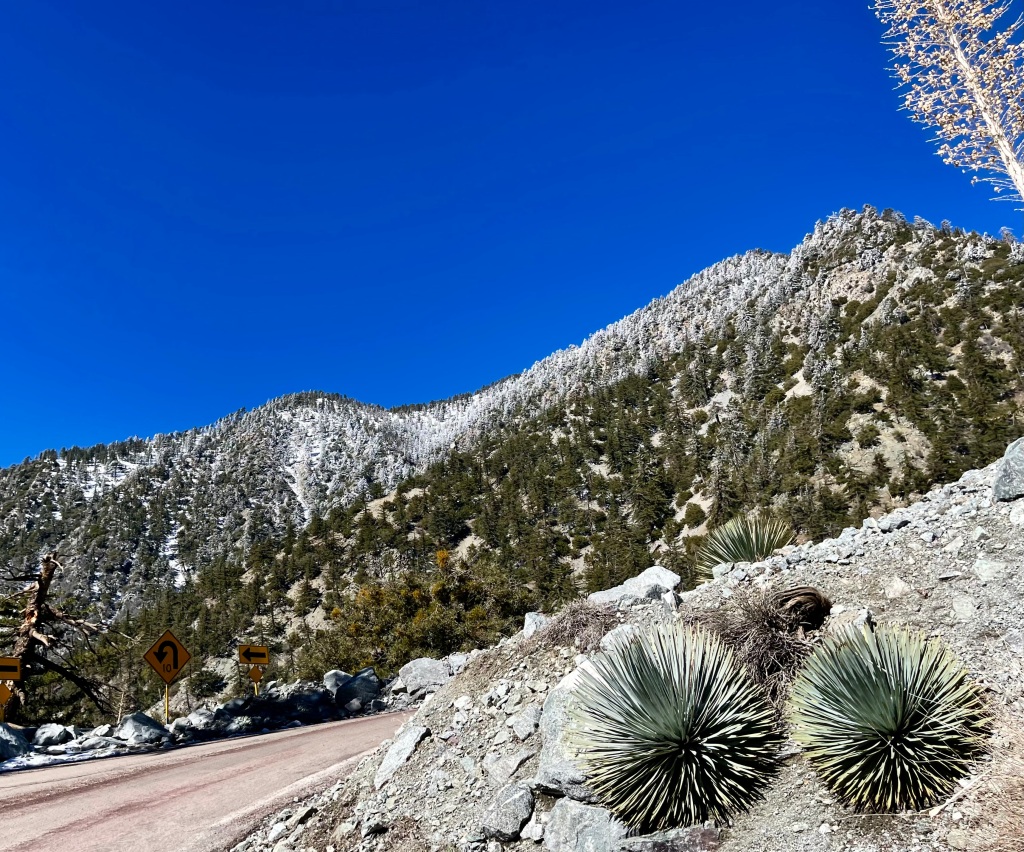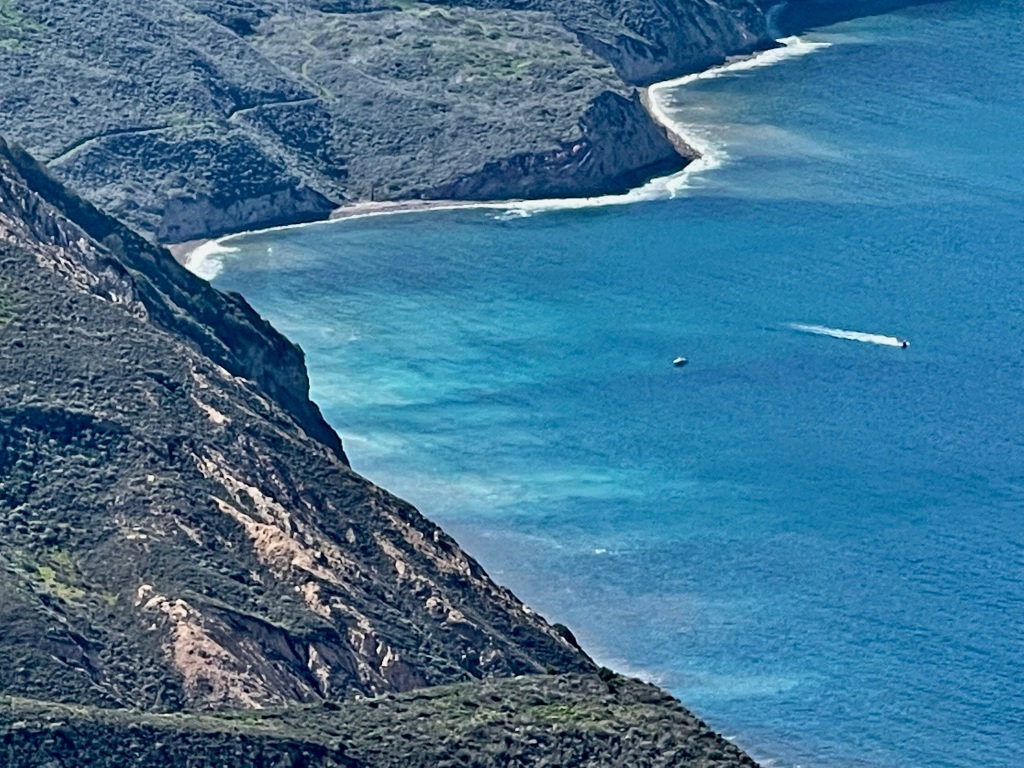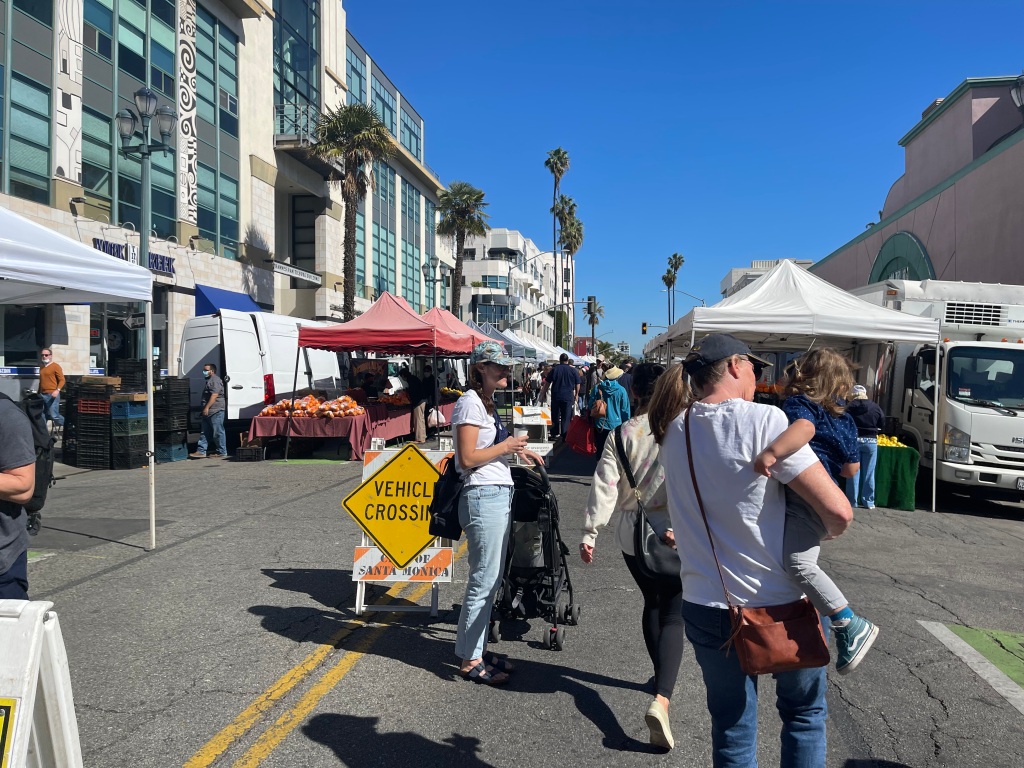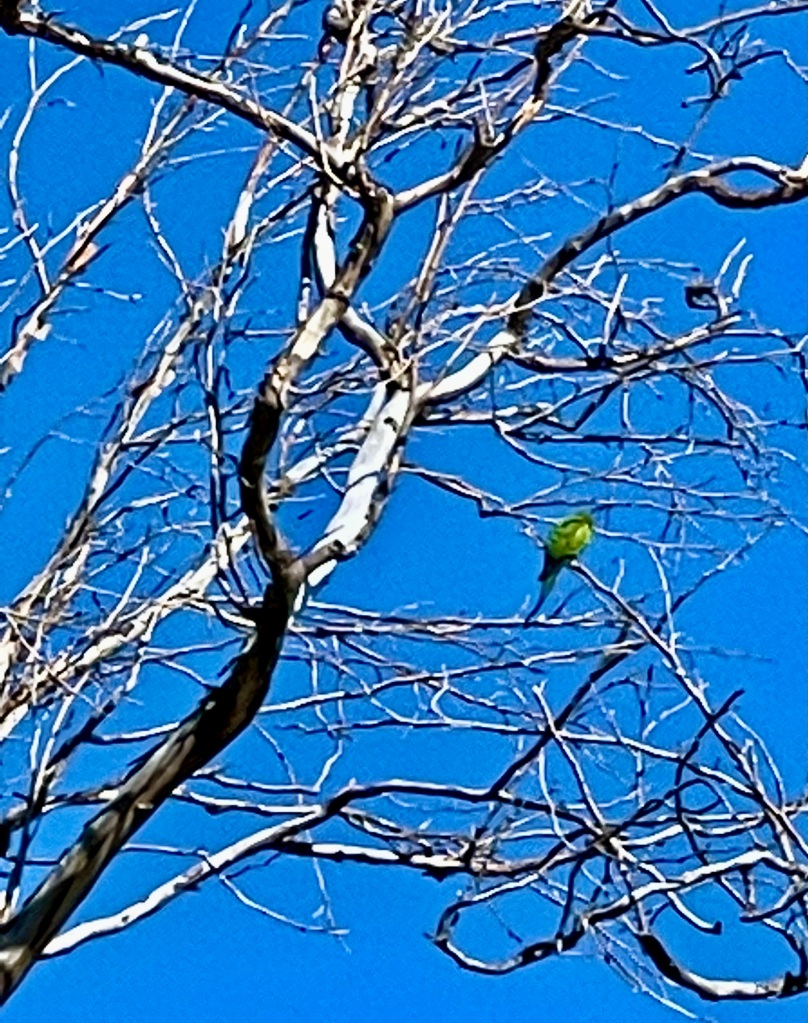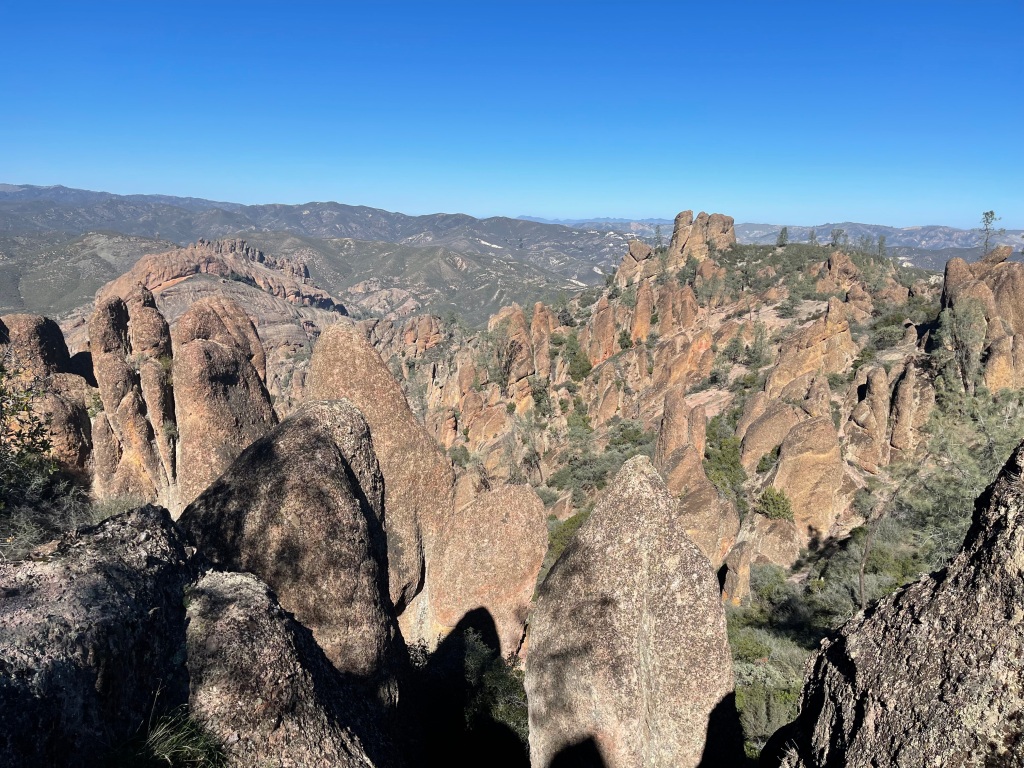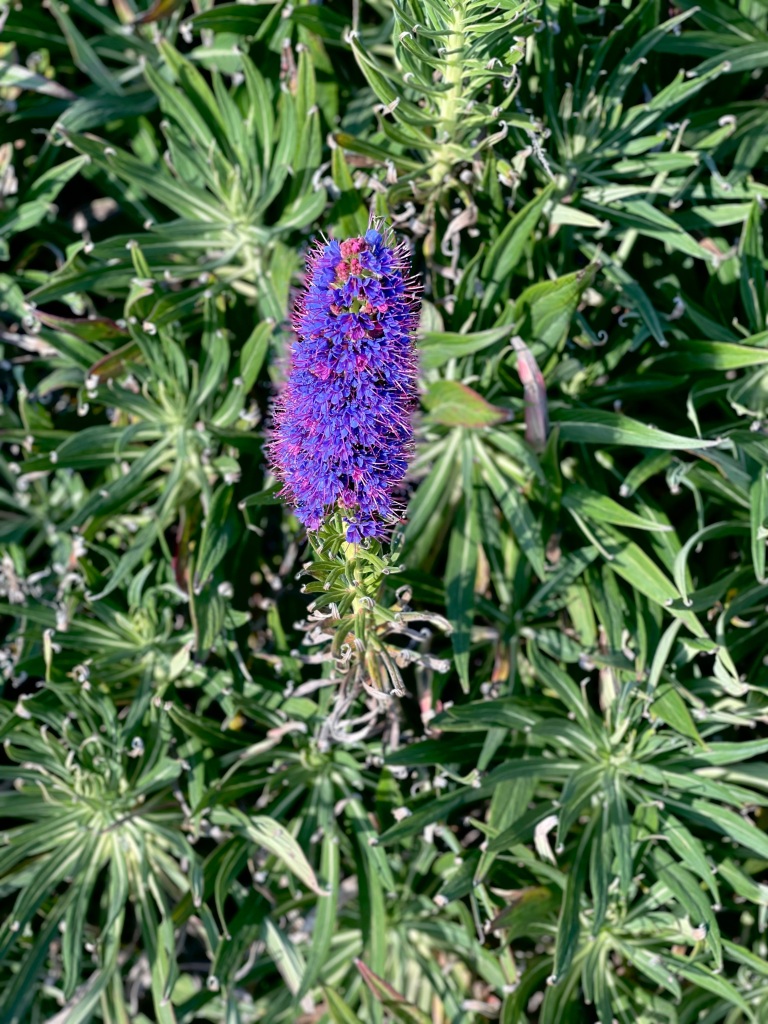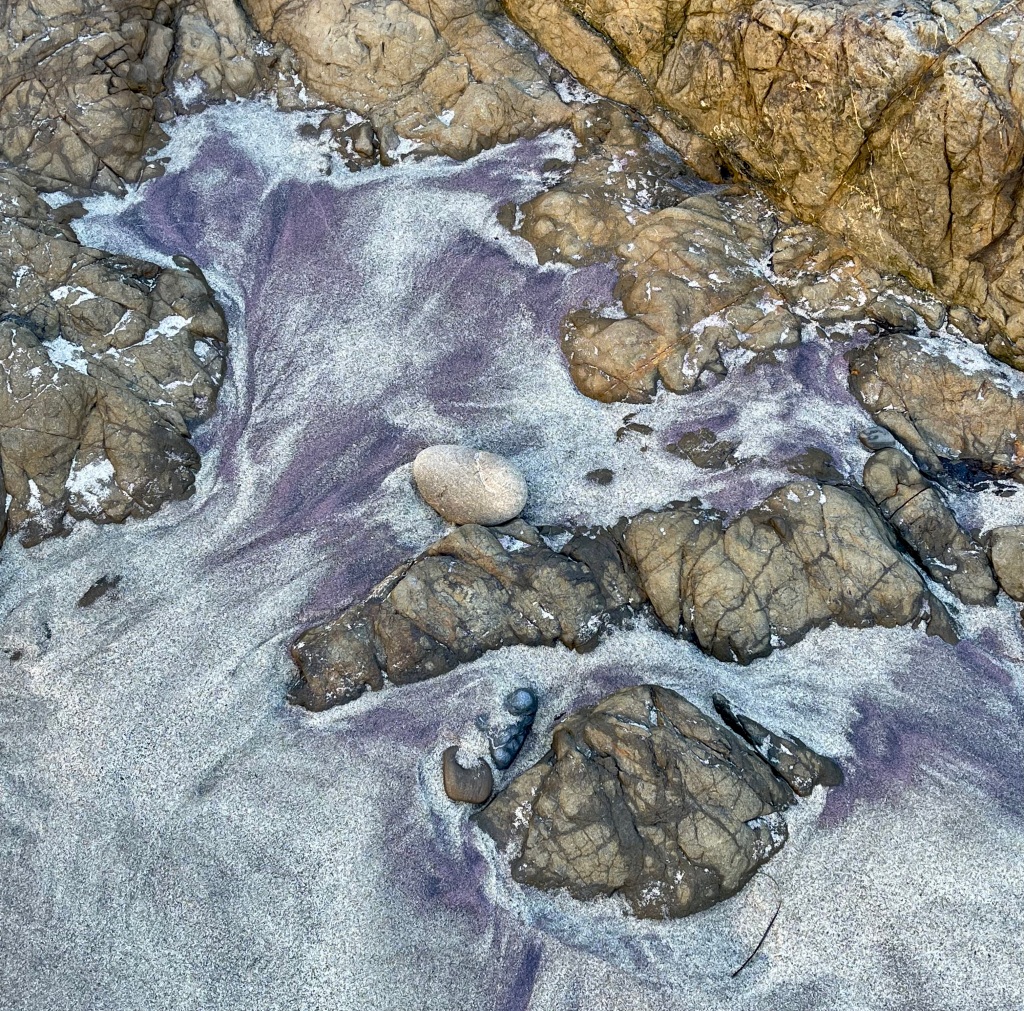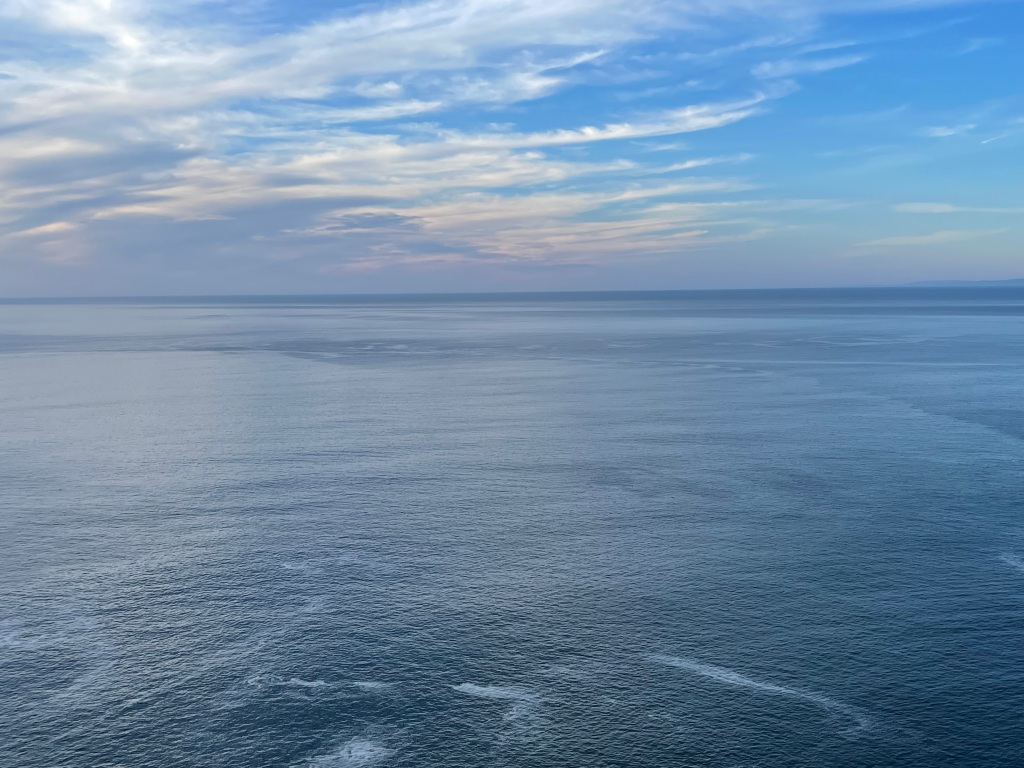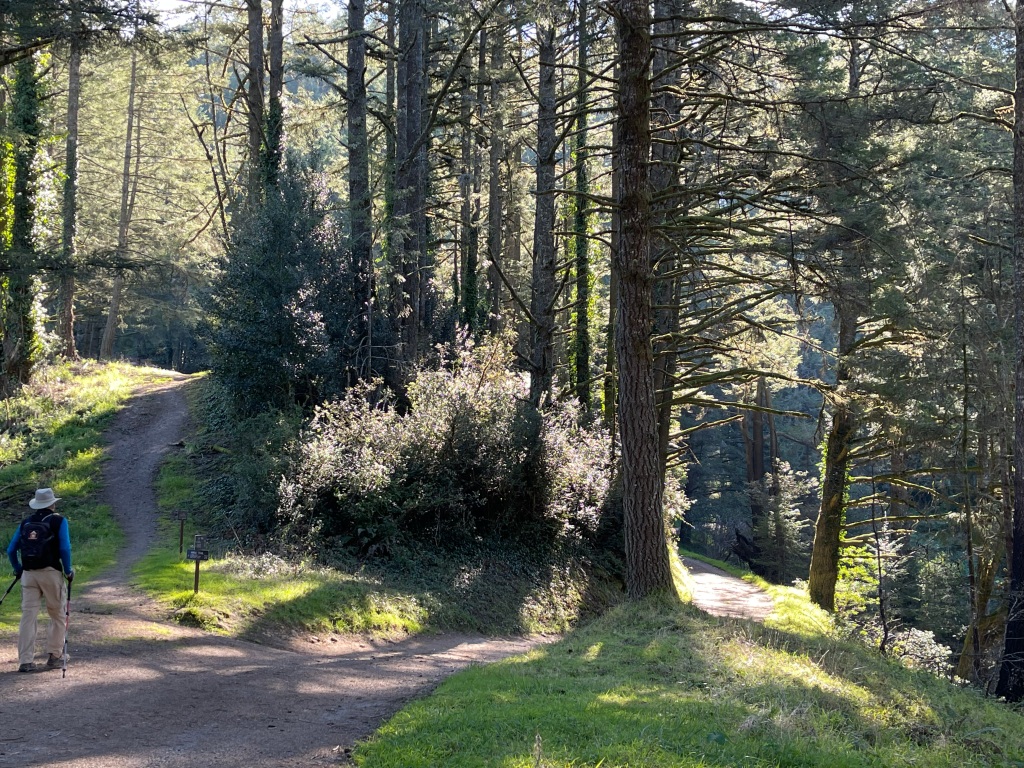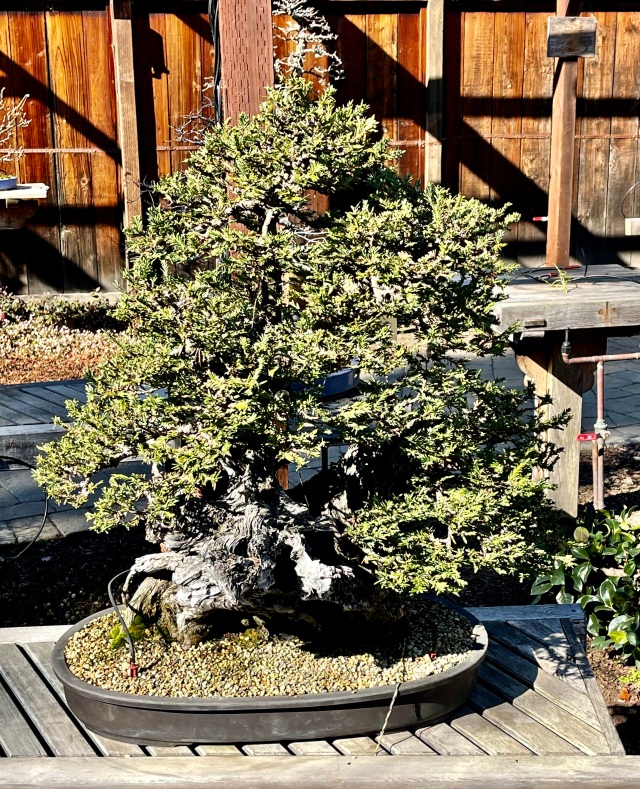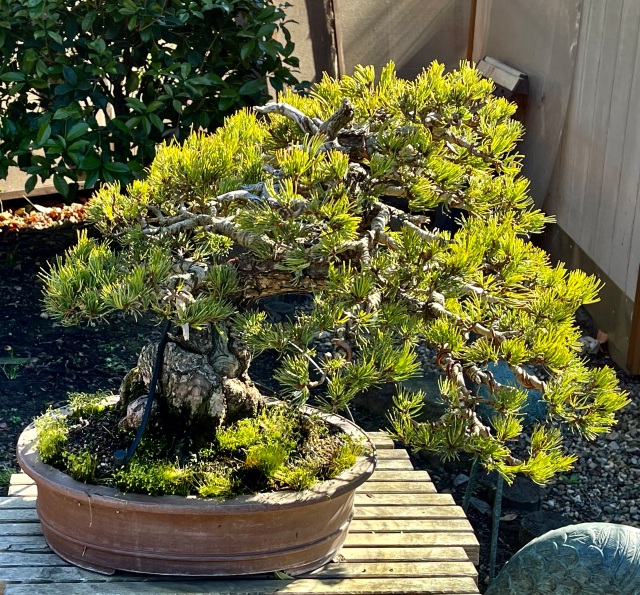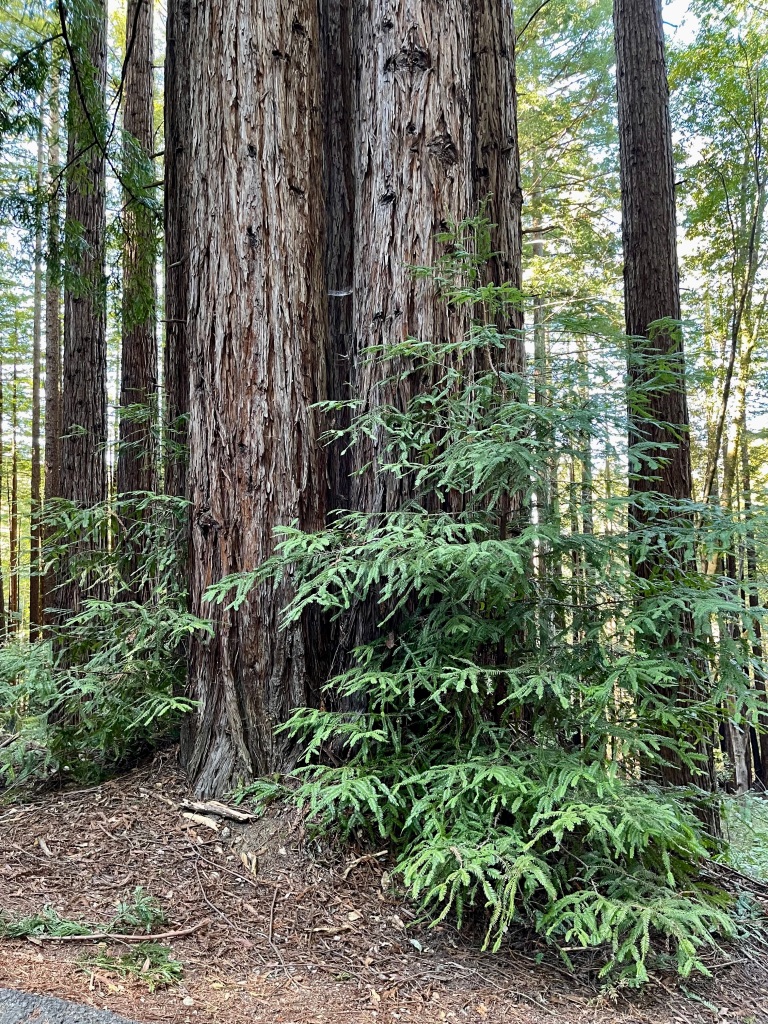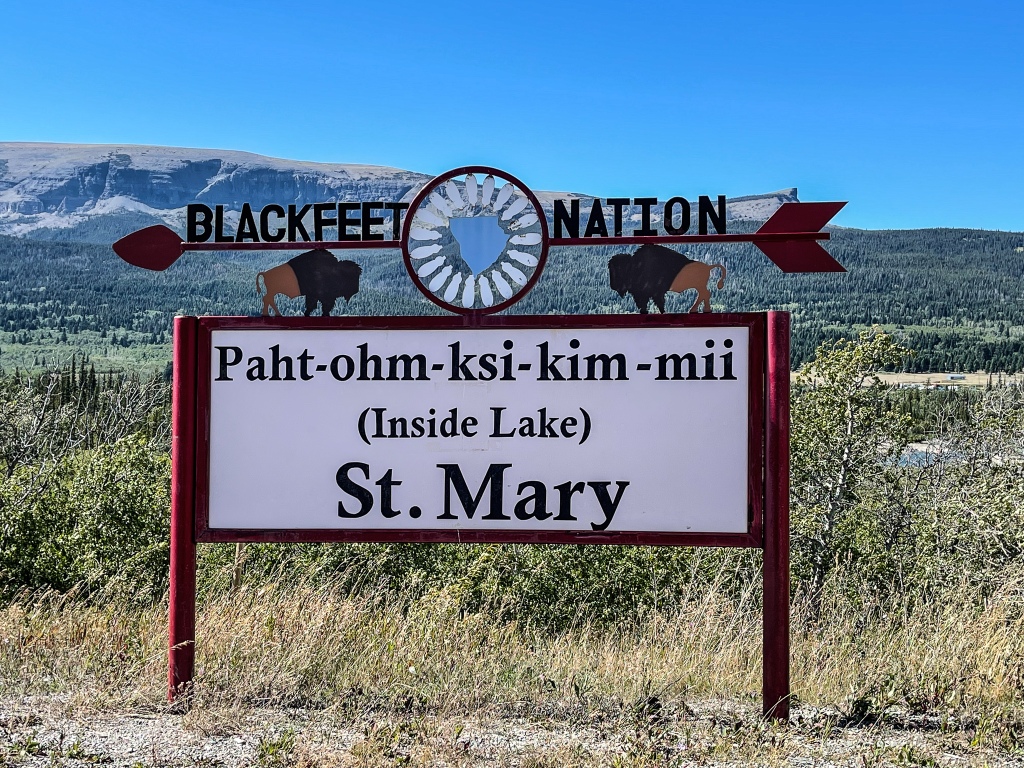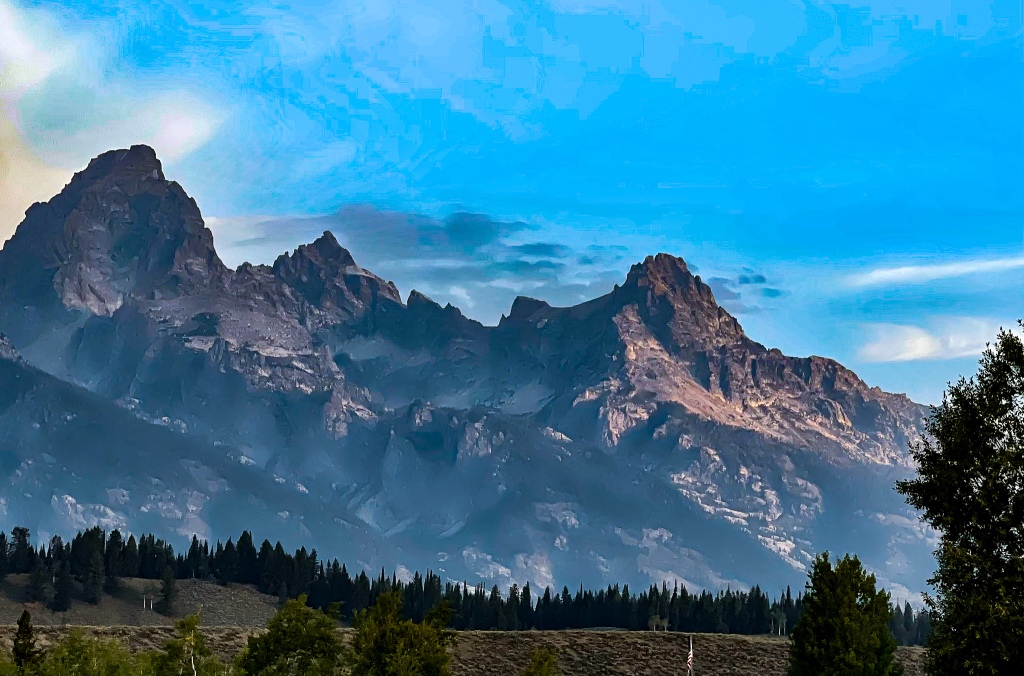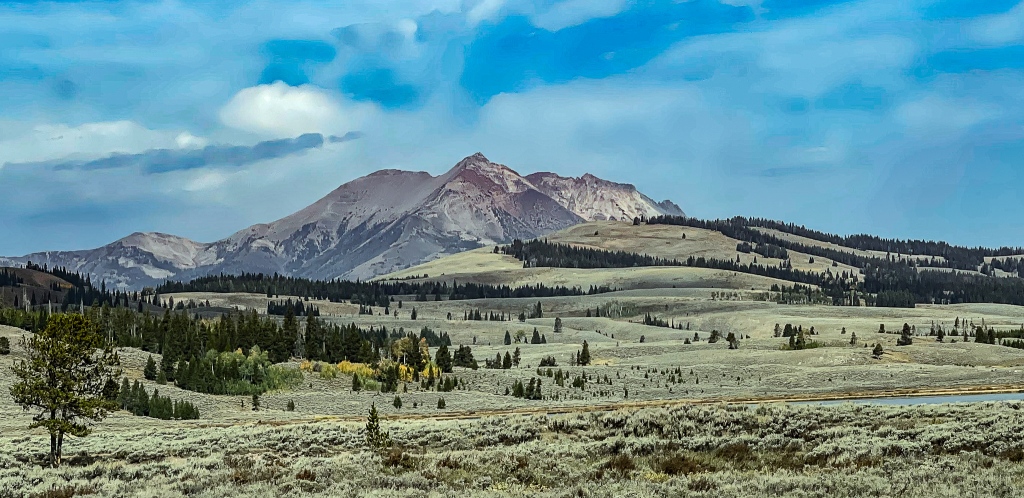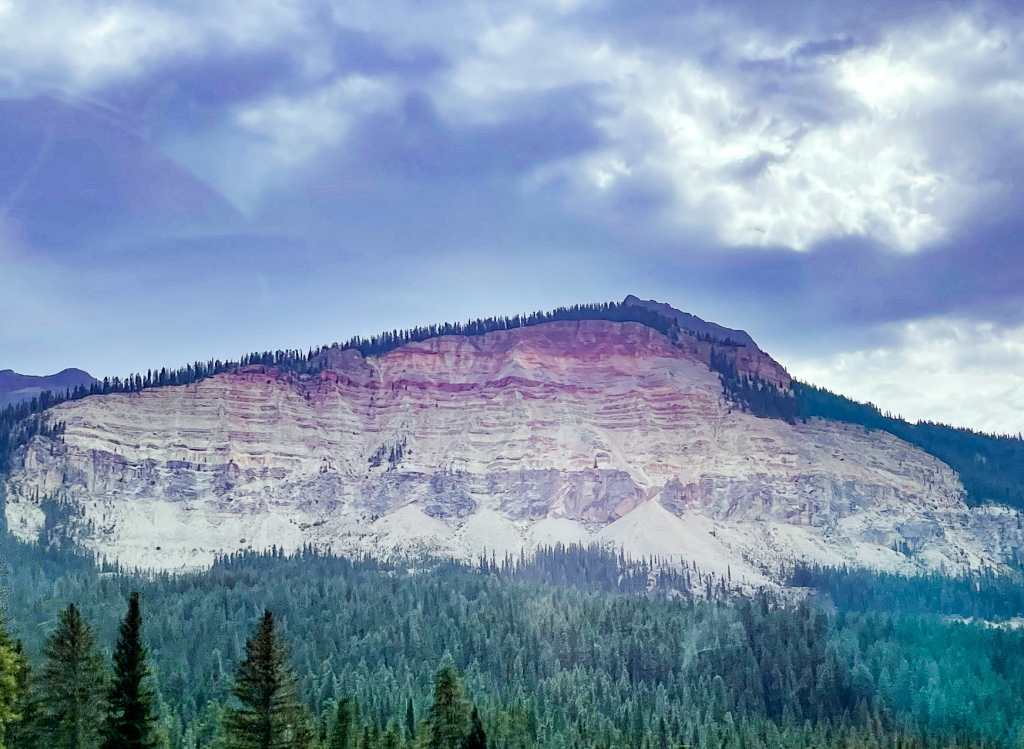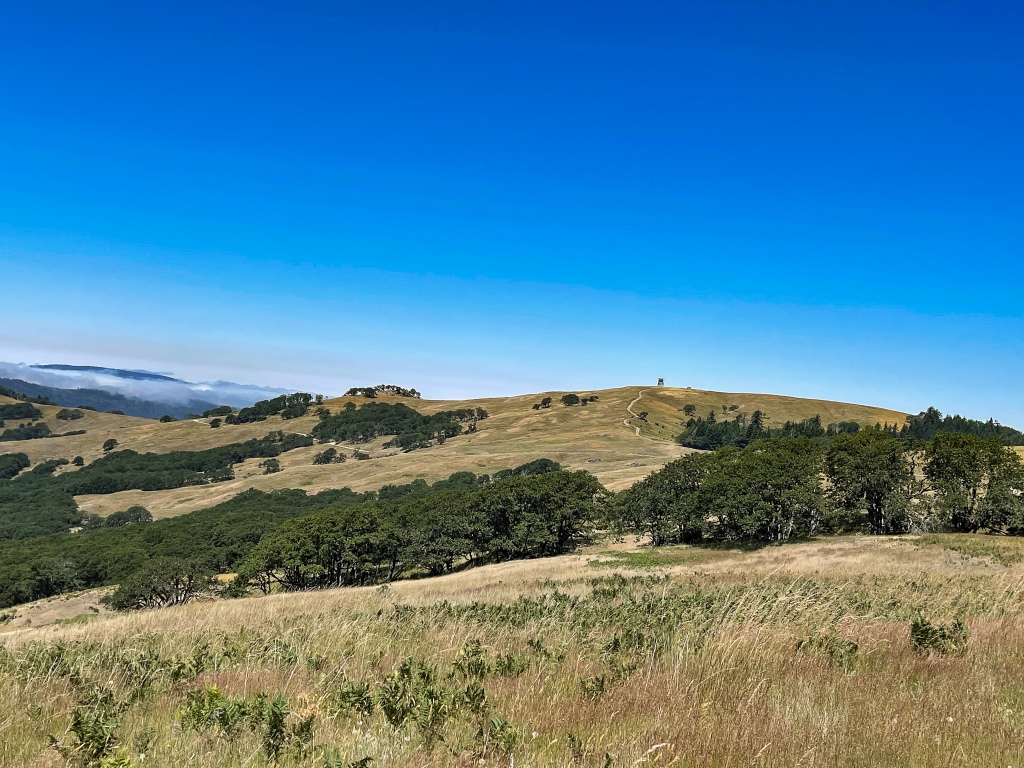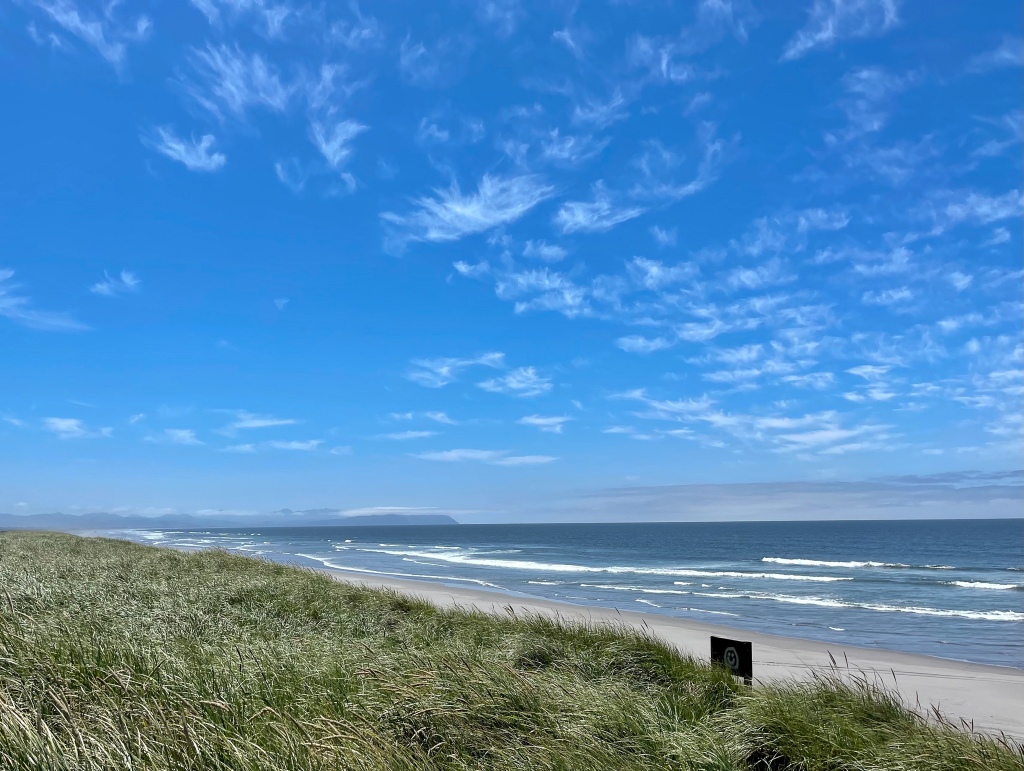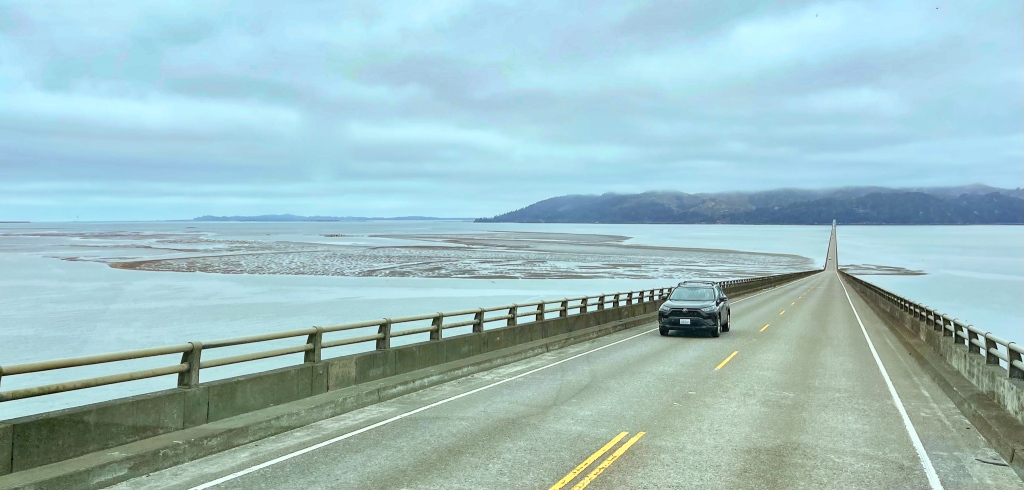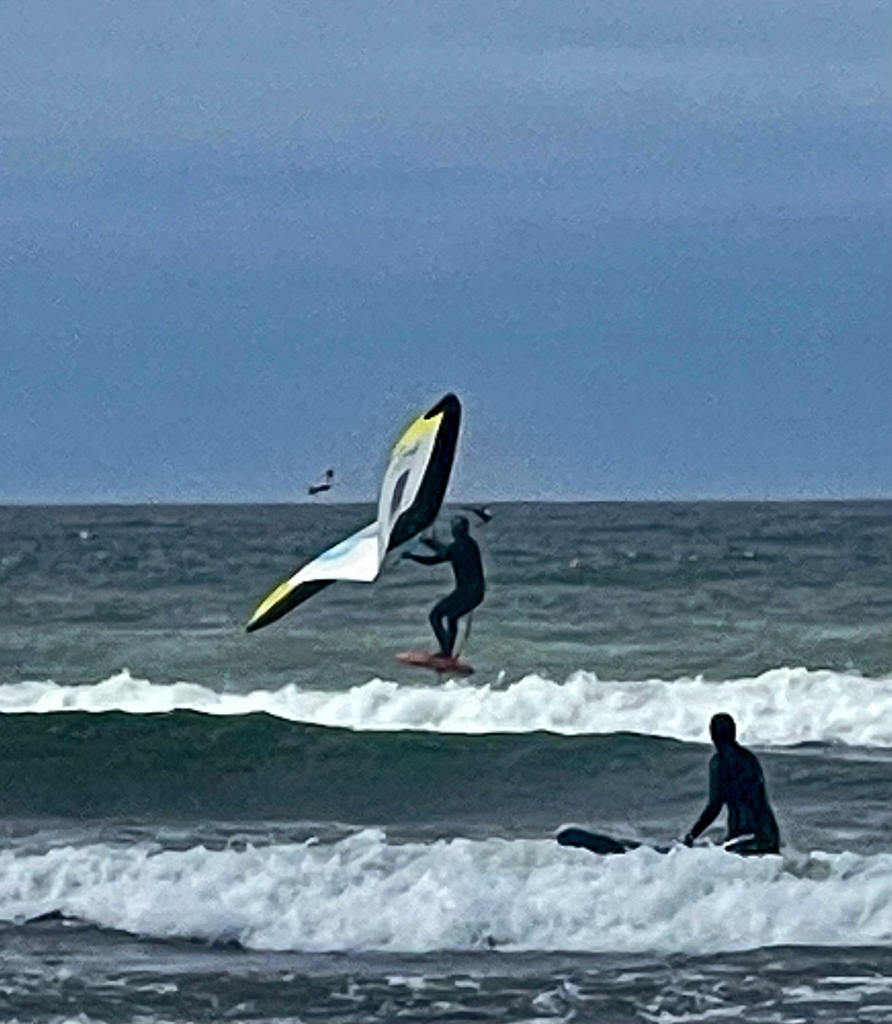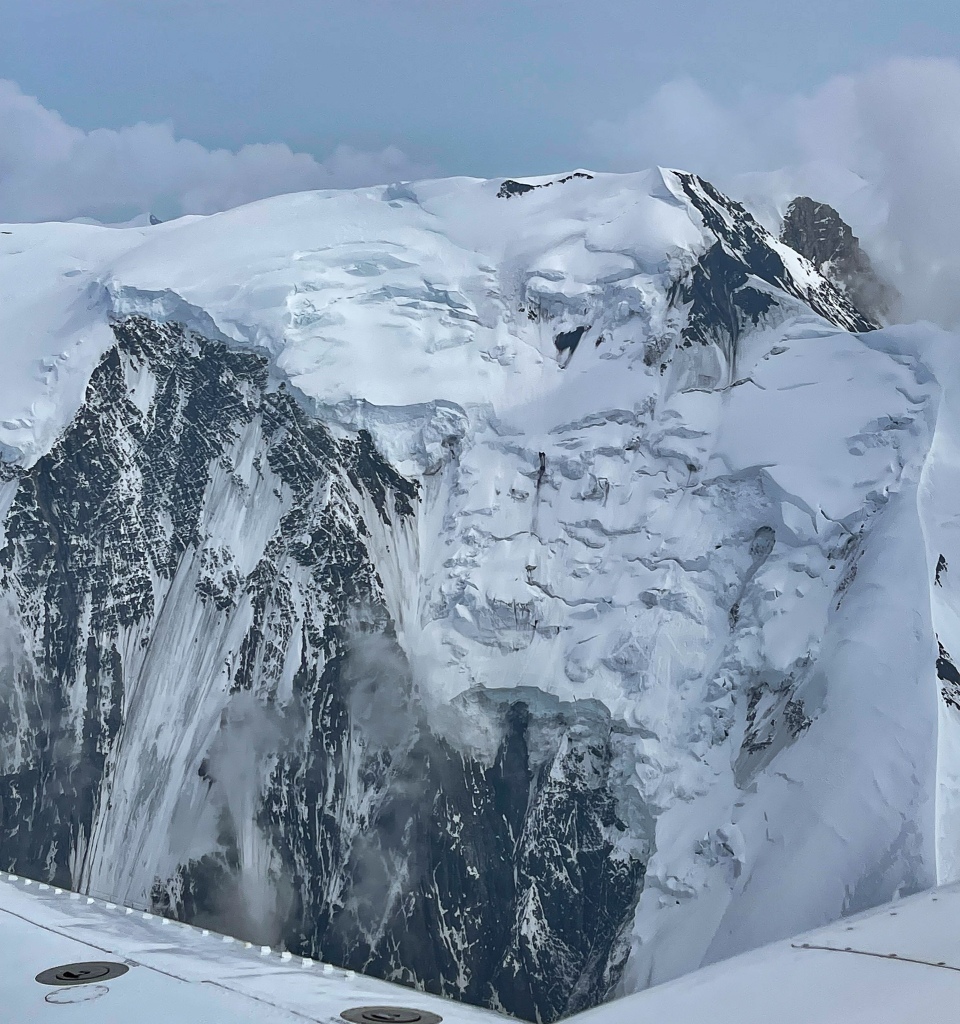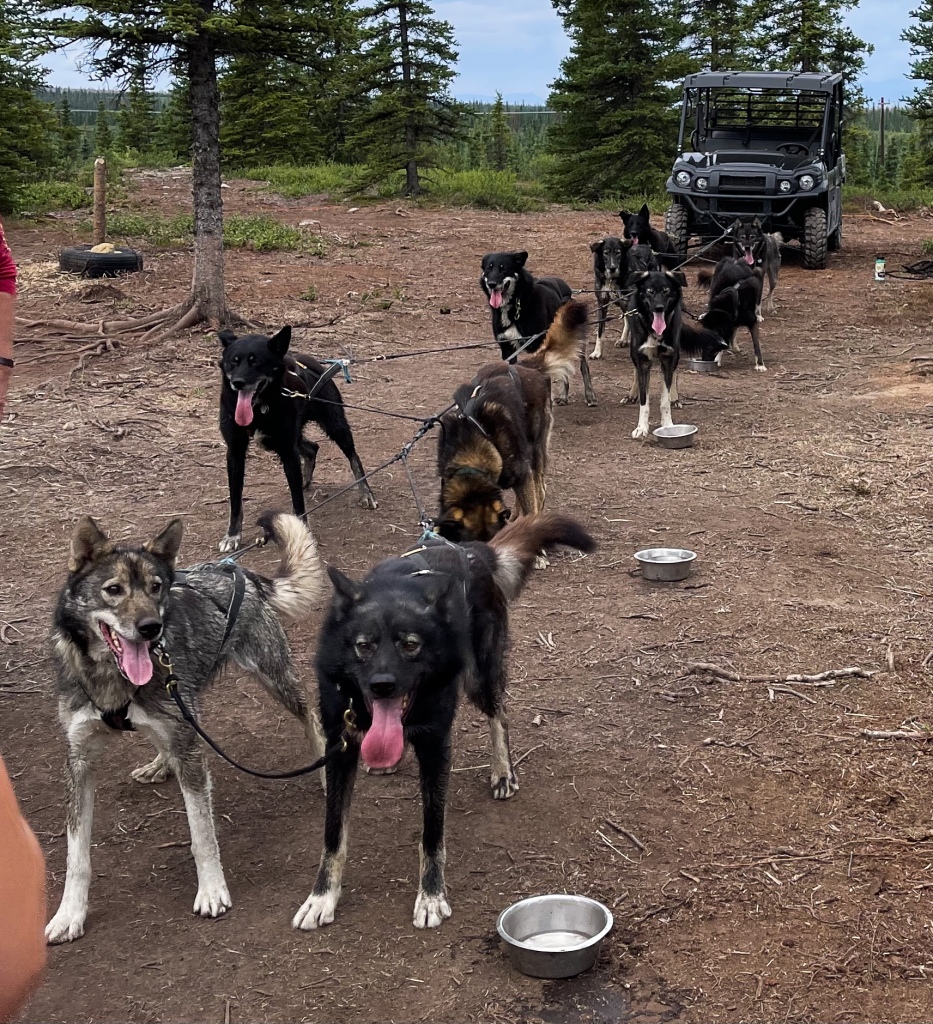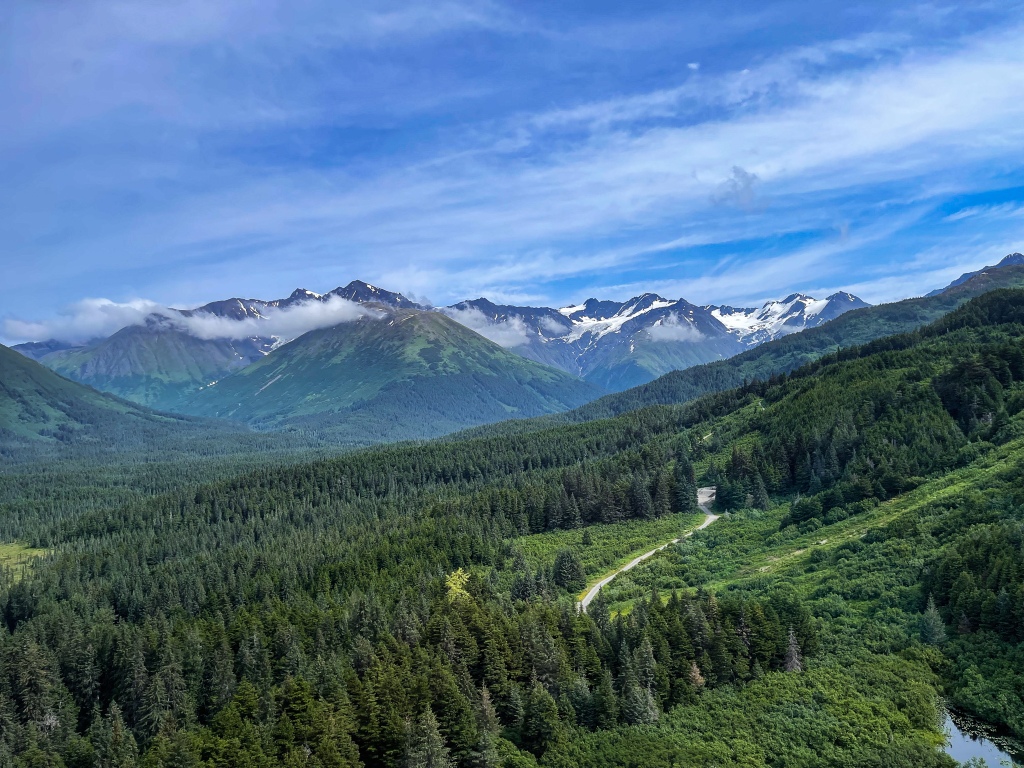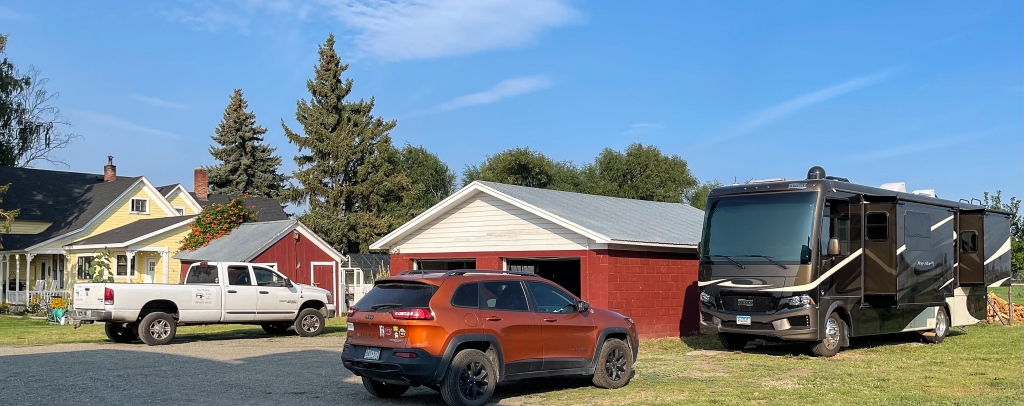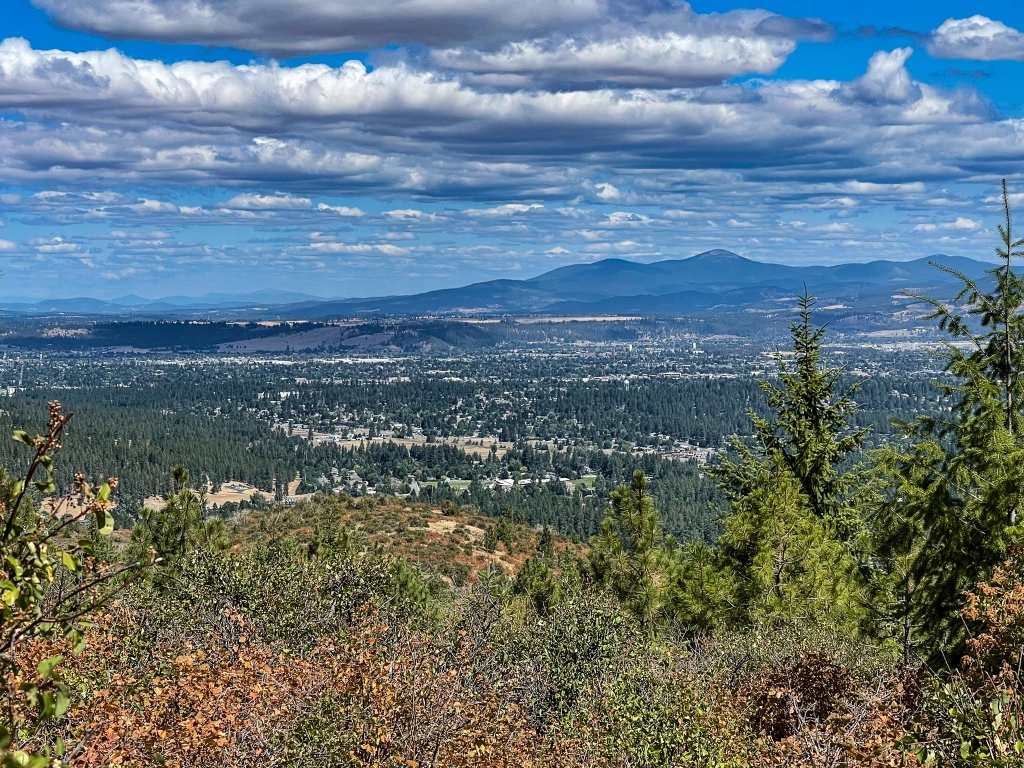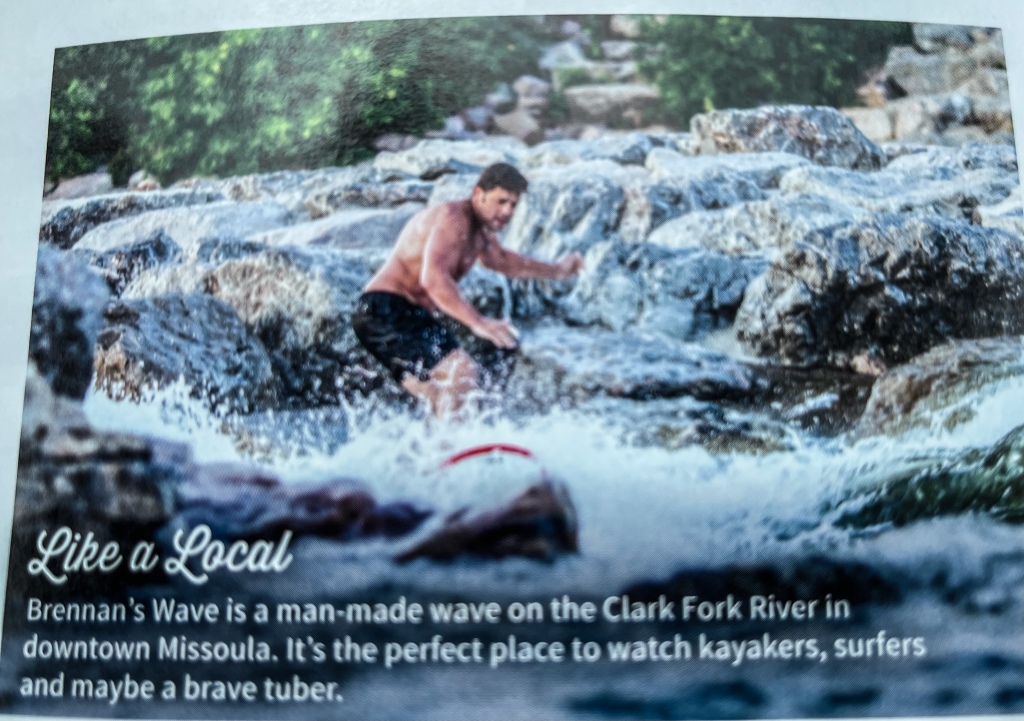[Please note: Photos that go with this posting can be found in two links. The first is at https://www.smugmug.com/app/organize/SmugMug-2022-Fall-2 .Simply double-click on the first thumbnail photo and you will then see it full-size with caption. Advance using the swipe arrow to the right. When you reach the end of photos in this Gallery (it recycles to the beginning), then click over to here: https://www.smugmug.com/app/organize/SmugMug-2022Fall.
This is the last posting that willl be made for our hiking adventures, as we are shifting focus to travel beyond North America. We’ll let you know where and how those posts will occur in late 2023. Be well, dear readers!]
As y’all know by now, we totally groove on the mountains. And starting with our last driving trip to Sacramento to pick up the Moho (From now on we’re flying back and forth), we have grabbed the gusto of the ranges.
Admittedly, there aren’t many ranges in the Dakotas and even in Wyoming. Until you get to the far west side of WY, it’s mostly hills and gulches. But starting with the Fossil Buttes National Monument west of Kemmerer, WY, the gorgeousness of the Rocky Mountains starts to reveal itself. We ogled a few of the 500-million-year-old fish fossils and crustacean remains at the NM, and then headed to Park City UT for a night. PC has of course exploded with development and population since we were last there in the ‘90’s, but it’s still a beautiful perch in the Wasatch Mountains east of Salt Lake City.
The real prize came when we stopped in Elko, NV to redo our jaunt into the Ruby Mountains. Avid readers of the Goatrekkers blog may remember last winter when we mired our Jeep in deep snow on the road into Lamouille Canyon…but August is the perfect season for a retry, and we LOVED it!!!
Lamouille Canyon is a 100-million-year-old glacially carved wonder, and someday the surrounding Ruby Mountains will be a National Park or Monument, they’re that gorgeous. We took a 2-mile hike upslope just to get ourselves acclimated to the elevation and stretch the muscles. Spied two golden eagles hunting and achieved some Zen, courtesy of the mountain streams. Didn’t quite make it to the high glacial lakes, but lunch by the stream was sublime. Our hotel that night in Winnemucca was also quite the thrill, as we crossed paths with the Geronimo HotShots, an elite group of firefighters from the southeast Arizona Apache reservation (near Chiricahua National Monument). These guys are legendary for their bravery and skill in fighting the most extreme forest fires. We were in the presence of greatness!!
——————————————————-
Once in Sacramento for 1.5 days of travel prep (stocking the Moho with food and dry goods), we took a break for some Farmers’ Market treats and a hike next to the beautiful American River in the Folsom district. 3.5 miles through the Jed Smith Riverbank Park suited us just fine, among the California Buckeye trees, fall fuchsia plants and live oaks. Lots of joggers, race-bikers, racing sculls, standup paddleboarders and hikers keeping company as well!
——————————————————-
Today we’re off to Yosemite NP, fleeing the 110-degree frying pan of Sacramento. We’ll see how much heat we can shed as we climb to elevation (Update: not much). Charred stumps from recent fires looked like black bears around every corner! This is ancestral homeland to the Miwok, Paiute, Yokut and Shoshone peoples.
Hah! At the western edge of Yosemite, the heat is still brutal. It’s the tail end of Labor Day weekend, but not everyone has fled back to the city yet. So, we’re picking our hikes very carefully and hitting the trails early.
As usual, we did reconnaissance the first day to scope out the park’s center: Yosemite Valley. Decided not to go back until Tuesday when holiday crowds have thinned. Beautiful shots of El Cap and Half Dome in late afternoon sun, though. 😊
——————————————————-
Today we tackled Tuolumne Grove (25 old-growth Sequoias) and May Lake at 9,000-foot elevation along Tioga Road. Just perfect starter hikes for us as we ease into longer, more strenuous trails. Yosemite has two forest fires at present, the Rodgers Fire east of Hetch Hetchy dam and the Red Fire southeast of Yosemite Valley. The former appears mostly contained, while the latter is still raging and perhaps growing stronger. Smoke rising from them is visible along the ridge road.
——————————————————-
Reveille was at dawn today, as it takes a full hour to get from our campsite to the Upper Yosemite Falls Trailhead. Driving east into the park, the fire closest to the valley was clearly much worse today, as the sky was orange, and the smoke was even heavier than yesterday.
Our trail target was a 5-mile hike up to Columbia Rock and back, ending in a spectacular outlook over the valley floor and major rock faces. But once on the path, we could see nothing in the distance due to thick fire smoke, which also made breathing very laborious. September brings millions of black flies to this park, and many of them were on the trail with us, adding annoyance to the effort of the climb. Two-thirds of the way up to Columbia Rock we headed back down. Just too little oxygen/too much smoke for a strenuous hike today. Instead, we scoped out Mirror Lake Trailhead for Thursday and walked a couple miles around the valley floor.
It must be said that Yosemite is a very unusual geological landscape, as national parks go. Its 38 towering domes, countless boulders, slabs and walls are dominant remnants of granite magma columns that slowly rose up through the earth’s crust but did not break the surface. As the upper crust eroded away over millions of years, the curious “fat missile” shapes seen in the domes emerged. Glaciers further eroded some of the dome sides, leaving walls like El Capitan, and millions of boulders and talus slopes. The granite here is mostly white (high quartz and feldspar content), except where prevailing moisture has stained the rocks a streaky black or encouraged lichens to grow. It’s just like nowhere else.
——————————————————-
Today we got to the northern Hetch Hetchy Reservoir as early as Park Rangers allow, which is 8am for gate opening. Temp was 75 degrees, with a puffy popcorn cloud sky. Started up the north side of the water to see Wapama Falls (5-mile round trip), and by the time we returned to the dam it was 96 friggin’ degrees, and 105 degrees at our campground! Thank goodness for some trail shade from Sierra Junipers and Cedars, but the trees are dying here, too. The waterfalls dried up after mid-summer, but the rock walls themselves were just as beautiful as in the Valley. No wonder John Muir fought so hard to prevent Hetch Hetchy from being dammed.
We mostly had the rocky trail to ourselves on the way to the dry waterfall, except for two backpackers who’d been in the wilderness for seven days, a lovely swooping kestrel showing off for us, a lone mountain quail, white-shouldered squirrels, and a work crew building new wooden bridges around the Wapama water flow. Every year, hikers are swept downslope to a frigid demise in the reservoir when they ignore ranger warnings not to cross the bridges during snow melt runoff. The new bridges are intended to lessen the risk to all.
To be honest, in Yosemite nature seems to be playing a requiem for many of the park’s native plants and animals. Climate change, two decades of wrenching drought, and wickedly high summer temperatures are a trifecta force that is going to kill a good share of the trees that forest fires have not yet managed to burn. The natural burn-to-return rate is now 20 years, but the fires are so much hotter because of too much fuel. The granite domes and walls will endure, but a lot of flora and fauna will either migrate away or perish in the next decade, not to return for possibly hundreds of years, if ever. Yosemite of the near future will be a drier, hotter place, trending in the direction of Death Valley or Joshua Tree NP.
——————————————————-
After yesterday’s beastly weather, we opted for a rest day today and drove to Tenaya Lake on the Tioga Road. The Valley was rated hazardous for air quality, so no hike to Mirror Lake (rumor is that it’s more like a meadow now anyway).
Tenaya Lake is magnificent, clear and cool, full of fish, and deserves recognition for its own mirror quality. Depending on one’s vantage point, you can get a gorgeous reflection of Sunrise Mountain, Medlicott Dome, Polly Dome or Mt. Hoffman off the water, as they surround Tenaya. The wooded 3.5-mile trail around the lake is full of Mountain Hemlock, Jeffrey Firs, Lodgepole Pines, multiple varieties of heathers and heaths, and countless mountain azaleas!!!! They probably bloom before Tioga Road is open again in May….must be spectacular to see them against the white granite boulders!!
Saw numerous climbers up on the near-vertical slopes of Pywiack Dome, as they sharpened their skills. Wow. Never would we ever……
A short discussion with an experienced and well-informed ranger left us feeling better about the survival rates of some species in Yosemite. Apparently, Black Bears are doing well along Tioga Road, teaching their cubs to prey on the mule deer fawns instead of other animals who have become rarer. Also, the NPS no longer fights periodic infestations of beetles, moths and other parasites that kill off selected tree populations. It’s nature, and they let it be.
——————————————————-
We left Yosemite today via Tioga Road, filling our eyes one last time with the glories of Tuolomne Meadow (a large, high open space where the Miwok, Yurok, Paiute and Shoshone tribes met for shared ceremonies, meals and trade for many centuries), the granite domes of the Eastern edge of the park, and the abrupt and dramatic change in geology when descending from Tioga Pass to Lee Vining.
Now ensconced in Bridgeport, CA, we’re acclimating to high altitude hiking by beating the challenges of breathlessness, fatigue and overcoming cranky joints one day at a time in the high Sierras. First day was about scoping out our territory, visiting the Travertine Hot Springs, the 1849er Gold Rush town of Bodie (now a great ghost town), and inspecting the Virginia/Hoover Lakes area as a hiking target for tomorrow. Weather is blessedly back in the tolerable range, and likely to continue to a daily average of 75 degrees.
The Travertine Hot Springs just south of Bridgeport were wonderful, a real-time example of how silica-rich layered rocks like Agates are formed. The springs have been here in the valley for millennia, boiling up from the deep-water sources which heat the mineral-rich fluid to 110-115 degrees F. Multicolored silica deposits itself around the spring pools, forming travertine marble in amber, grass-green and white shades of translucent rock. To see this forming before one’s eyes is enchanting. The ultra-fine mud around the pools is EXTREMELY slippery, which caused George to do some rapid-fire balancing and interesting dance moves while getting his hiking sandals full of said mud.
We chose not to take a dip in the waters, as we’d been warned that they harbor bacteria which can lead to infections. But lots of others were there for the purpose of a good soak, contributing to an atmosphere much like a Grateful Dead concert. From the springs, we drove 13 miles into the eastern hills to visit Bodie, CA
As a ghost town, Bodie is much bigger than Tombstone, AZ (made famous by Virgil, James and Wyatt Earp), and Bodie’s purpose was distinctly different from the latter. At one time as large a city as 8,000 people, Bodie was filled with miners, merchants, schoolchildren, entrepreneurs, 10 to 15 mines, and yes, taverns and ladies of the night. Gold mining there and much of the population lasted until the 1920’s, then began to fall off and the gold mining ended in the late ‘30s. The state of California now operates it as an historic site and keeps the buildings stabilized as well as the furnishing intact to be viewed by the public. Amazingly, the townspeople enjoyed electricity, telephone service and running water lines from early on, long before many other communities in the state! In a word, wealthy!
Heavy rains and thunderous hail joined us on the drive back to camp in late afternoon, which ensured blue skies for the following day’s hike.
Initial investigation of hiking in the Virginia Lakes area proved enticing, so the following day we returned to the 9,800’ trailhead in the Hoover Wilderness section of the Humboldt-Toiyabe National Forest. Our goal was to hike four miles round-trip, and every minute on the trail was superb. We gained 800’ in altitude and saw four gorgeous mountain lakes, nature’s bonsai forest at 10,600’, a multitude of very noisy Clark’s Nutcrackers, the very last blossoms of heather, monkey flower and lupine, and more scree fields that we have in a long time. Per my onboard Merlin app, we also heard Brown Creepers, Northern Waterthrushes, Mountain Chickadees, a Western Screech Owl, Rosy Finches, Golden-crowned Kinglets and Hairy Woodpeckers. We also saw a gorgeous Osprey who’d just fished his trout breakfast out of the lake and was hungrily digging into it.
A bird hunter who’d been up to Virginia Pass at 11,000’ and bagged two white Ptarmigans crossed paths with us. He’d hiked up there for the past eight years and only today found his targeted prey. So interesting. Ptarmigans were brought to the High Sierras in the 1970’s from Alaska, and as of today they are doing very well in this habitat. American Sage Grouse, a threatened species, can also be found on the sagebrush plains in the valleys of these mountains.
——————————————————-
The Yosemite fires just won’t quit, so once again we’ve got very soot-filled skies today. Hiking up into the Twin Lakes area should have been glorious, but we made the best of it on the Robinson Trail up toward Barney and Peeler Lakes. Winds cleared the smoke out for a bit, but heavy rain clouds brought a very low ceiling in and smoldering from the southwest finished the job of blocking sight lines. It’s ok, we had the most wonderful lunch spot to ourselves before returning to the car, and only had rain for the last 10 minutes of the hike.
——————————————————-
On to Mammoth Lakes today. Staying in a nice National Forest Service campground (Large camping spaces, no water, electric or sewer hookups) in town! Weather has definitely turned to the cool side now (60s daytime, 30s nighttime).
First of two hiking days takes us to Crystal Crag and Mammoth Crest Trail. It kicked our butts because we are still working on our altitude adjustments. It was only a 5.6-mile hike but gained 1500’ to bring us up to 10,500 summit elevation. Lots of lung-burning, breathing hard up top due to less oxygen, and the need to stop every quarter mile for our heart rates to slow to normal again. But this is typical on the front end of an adventure, so we’re not worried.
The immaculate Mammoth Crest trail wended its way upward via switchbacks through a mixed conifer forest of Lodgepole Pines, Ponderosas and hemlocks, then as we neared the top, every species gave way to white-barked pine (the preferred food of the Clark’s Nutcracker again!). Very little birdsong today, but the views of the glacial lakes were superb! Fascinating geology — we noted granodiorite boulders early on, which, as we moved upslope, were then replaced by cinders and copious chunks of pumice in many different colors. These volcanic peaks must have seen some explosive lava-ash throws, as the cinders and pumice were thrown 300 miles east from the peaks.
The sight of Mammoth Mountain, desolate, treeless, and coated in blond andesite rock on the south side, was quite surprising – the north and east sides are full of trees and ski slopes!! It is the biggest ski resort on the Eastern Sierra side.
Also visible from the top of the crest are the sharply peaked metamorphic granite Minarets, the signature skyline of Mammoth Lakes. The minarets are fairly close to the famed Devil’s Postpile National Monument and its imposing jointed basalt columns. There is a great deal of nature and geology to see here!!
——————————————————-
One could only describe today as adventurous. The hiking was magnificent, but we started with the adrenaline rush of a bear encounter at the trailhead. George had gone back to the car for something forgotten, and I saw movement along the trail but no human head or colorful backpack. After 6 years’ hiking in bear country, I knew it was not a human but likely a bear.
Sure enough, a juvenile black bear ambled down the path toward me, and so I started my deterrence measures. Raised my arms as high as they would go, started yelling “NO! NO! NO!” in my deepest, most threatening voice. The bear quickly ran off. Thank goodness.
Then the wonderfulness commenced, hiking up to Duck Lake off of the Coldwater Campground Trailhead. The clearest of blue skies, ideal temps for hiking (high 50s) and a lightly populated path. The trail is by turns hard and moderate, alternating rocky switchbacks with pine needle-littered straightaways over 4.2 miles upward. We passed five glistening aquamarine lakes and a meandering creek, then hit the rocky switchbacks for final ascent to the nearly 11,000’ Duck Pass. It is always a tremendous thrill to stand on the ridgeline between two valleys, and even though Duck Lake beyond is only a couple hundred feet below Duck Pass, it was magnificent to see into the distance on the other side.
Our path crossed with a pack string of obstinate mules, carrying belongings, food and beer up to the pass for multiple groups of fishermen on multi-day trips. We met the fishermen later hiking the trail. All younger than us and moving slower than us. It’s hard to stay in shape for altitude hiking when you’re still working for a living.
The down on this hike was a grit-teeth-and-bear-it 4.2 miles, as our feet and our calves are still not quite used to rock trails. But all was well when we found our ice cream cones in town. We hobbled home on sore feet, had a modest dinner and turned in early.
And there’s the rub.
We were so tuckered out post-hike, that some of our procedures lapsed. Forgot to lock the car. Forgot to take anything that smelled of food out of the car. Forgot to empty our backpacks of trail bars. And even though we had a pretty quiet night, the rangers knocked on our door in the AM and said, “A bear broke into your car last night.”
You can imagine that we feared the worst, coming out of the MoHo in our PJs. But we benefitted from enormous dumb luck – because the car was not locked, the bear didn’t have to break windows or pull off doors, he simply opened the car door and hopped in. He found nearly every edible item and ripped George’s backpack to shreds, but did not tear up the seats, punch holes in the leather or damage ANYTHING in the process. Dirt on the seats, dried drool on the seat backs and dashboard, and pine needles told us he’d been there, but otherwise, nary a trace was found. Just a few scratches on the outside, no biggie.
I’m still just a little hyperventilated from the break-in, but more importantly, we’ve vowed never to lapse in the removal of any food items (incl. wrappers, napkins, sandwich bags, even gum!) at the end of day. Even when exhausted. Wow, that was close.
——————————————————-
Now in Bishop, about 60 miles south of Mammoth. This is a town primed for tourists, with a nationally renowned bakery, kickin’ tourist bureau and plenty to do in the area besides hiking and fishing.
Speaking of hiking, we knocked off two beautiful hikes over three days.
First up was a 6.4-mile long hike up 1420’ to the Treasure Lakes area off of Hwy 168 (Bishop Creek Canyon). We are quite taken with trails up mountain valleys and canyons with glacial lakes along the way. Treasure Lakes is a verdant high valley with gorgeous Lodgepole and Whitebark pines, azure lakes and spiky cathedral-topped peaks for anyone who loves the thrill of dramatic geology. The trail is bounded toward the end by 12,000’ Hurd Peak, 13,000’ Mt. Goode and 13,000’ Mt. Gilbert. A more interestingly named peak is the Cloudripper at 13,500’, but we’re not sure whether we saw it or not.
For lunch, we reached our turnaround point at the end of a steep boulder-scramble up to a scenic and still-humid waterfall fed by the South Fork of Bishop Creek. We were able to scramble to a huge boulder sitting in the middle of the creek and admire not only the fetching waterfall and hear its music, but also to get an eyeful of the bounteous crop of bright yellow Monkeyflowers clinging to the creek’s edge. It’s obvious that the cleft where we sat is a riot of color for the very short blooming season (mid-July to mid-Sept). There was evidence of prickly poppies, lupines, paintbrush, pincushion, Sierra lily, penstemon, fireweed, aster, mountain mahogany, columbine…and on and on. We saw many gentian foliages, as well, but not until the next day did we see blooms.
Second hike was a close cousin to Treasure Lakes, but more arid and austere mountains. We drove back north to Rock Creek Canyon, always a GREAT source of fabulous trails. Last time here, we hiked the Mono Pass trail (stupendous), and this time we opted for Mosquito Flat to Morgan Pass. The geology alone was breathtaking, with so much metamorphic granite up in the mountain peaks.
With even more lakes along the trail than along Treasure Lakes, this hike enthralled us. And so many fisher people along the way!! The entire eastern Sierra makes big business from fly fishers, and many people do backpacking combined with fly fishing. And the wildflowers still hanging on amazed us. Finally, we saw a gorgeous gentian plant in bloom and several clumps of heather in their pink finery.
The hike started off cold, at 40 degrees with wind. High gusts started a mile in, and then the snow flurries began. It never let up from there. The streams were even prettier than the day before, but there was no lingering this day. We huffed and puffed it up to Morgan Pass, a truly desolate saddle at 11,100’, and when we reached it, took two quick pix, peeked over the other side (which looked like the surface of the moon) and hightailed it down again. Wore winter gloves and down vests the whole hike. 40mph winds gave us windburn.
George and I can both tell that the strain of these hiking days, and being around 70 in age, is starting to catch up with us. Aches and pains and fatigue are harder to recover from. So, we’re taking the next day off, and perhaps the day thereafter. The North Rim of the Grand Canyon awaits next week!!
——————————————————-
We drove down to the city of Lone Pine on Hwy 395 in order to eventually hike a trail close to Mt. Whitney, the tallest peak in the continental US at 14,494 feet elevation, and to visit the US Historical Site at Manzanar. Due to yet another bad rainstorm in Death Valley, it appears we now have to drive a lot of extra mileage to route around Death Valley National Park, since the only road through the park is closed for the third time this summer, 6 days ago. Continual checking on that road status did not save us from a surprise.
After a quick set up in our RV park and lunch, we headed off to Manzanar, the WWII Japanese “Relocation Center” or as we know it, Internment Camp. The scope of this odious operation in US history surprised us, as did the conditions to which the residents were subjected.
The camp operated for 3.5 years right after Pearl Harbor. It imprisoned 11,000 Japanese (Issei) and Japanese Americans (Nisei), mostly from the West Coast and Hawai’i. In 36 sections of 14 tar-paper barracks each, with 16 people in each barrack, the prisoners were forced to eat, sleep, and use toileting and shower facilities with others outside their own families. They were not allowed to cook for themselves, got lousy rations, and in some cases had to stop practicing their religion.
Blowing dust is ever-present in this part of the Owens Valley. Today winds are gusting to 30 mph and our car doors are practically ripped away when opened. Can you imagine living in a tar-paper cabin (that might have been a horse stable last week), with nothing to stop the wind and dust? Water was scarce, wood was scarce and yet some people managed to repurpose fruit crates into very serviceable furniture.
Prisoners were subjected to taking a loyalty oath, be drafted for military service and/or forced to work in camp factories making camouflage nets for the war effort. All in all, the US deployed ten of these camps all over the West and Midwest, interning over 120,000 Japanese heritage people. Out of this population, 4,000 Japanese men were either drafted or volunteered, and fought honorably.
In 1988, President Reagan authorized a public apology to those interned in Manzanar, as well as a one-time $20,000 reparation payment. By then, only 60,000 survivors were still alive.
We are always glad to visit such historical sites because the stories must be told or we will repeat the episodes. But it makes us wonder if Congress would even authorize creation of a historic site such as Manzanar today, given our divisions.
——————————————————-
What an epic day! Crystalline skies with only the slightest clouds, 40-ish temps to start, and 10,000’ to gain!! This is our last Eastern Sierra hike for now, and we savored it.
The town of Lone Pine is Mount Whitney territory (tallest mountain in continental US), and we planned a two-day stay here just so we could go to the base and see it. All hikes that start at the Whitney Portal are just too strenuous for us today, but we did see it as up-close as possible. Stupendous.
Because this range along US 395 has so much variation in mountainous terrain, we didn’t have to go far for another hike that would be impressive. The Horseshoe Meadows trails south of Whitney were our goal instead.
These trails start out at 9,990’ and go up just 600’, through high meadows, lightly forested slopes and over several creeks. Why does it seem that mountain lakes and streams always look a shade of ultramarine that you never see at sea level? The water is electrically deep blue, just stunning!!
For almost a mile of our loop trail we were on the famed Pacific Coast Trail, and it was magical. Tall, thick and heavily weathered, the two widely spaced tree species up there are Lodgepoles and the relatively rare Foxtail Pines (looking like a relative to the sub-tropical Monkey Puzzle Tree!). Western Bluebirds can be heard regularly, and Black-Eyed Junco.
We’d just passed a spectacular lookout down a miles-long meadow (most likely Horseshoe Meadow that the trail is named for) when a wiry young man came striding up behind us. A through-hiker who’d been on the trail since July at the Canadian border, he was headed toward Mexico. So exciting!
The only way to meet up with through-hikers is either to see them at their resupply points or be hiking the PCT yourself. What were the chances?? We talked to him for 20 minutes, shared funny stories about hiking, then he went on his way and quickly disappeared in the distance. He makes 20 – 25 miles/day, every day, so can’t spend much time talking!
As it turned out, we only saw three hikers on our trail today, and two were through-hikers!
We ate lunch around Mulkey Pass (peak elevation for this trail), then started the descent into Horseshoe Meadow. Heavy rains had washed out the trail for ¼ mile, thank goodness we had Gaia on to keep us on track.
At the bottom of the descent, in the midst of the meadow instead of viewing it from above, we noticed how much coarse granite sand had been carried down by millions of years of snow melt and storm runoff. It’s enough to discourage any trees from growing at the bottom, as the ground is always shifting and getting more detritus on top. Pines are the only trees to successfully grow in sand, and up here, even they have to work hard to gain purchase. There was a lovely run-off and spring-fed stream, with dozens of bluebirds lounging in the grasses! More purple gentian (a family fave) scattered in the waterlogged meadow just put the icing on the cake for this hike.
We have never done as many high elevation hikes in a row as during this adventure. No wonder it feels like Nature is kicking our butts some days!!
On the hairpin highway down from Horseshoe Meadow we got an eyeful of the dry Owens Lakebed. 110 years ago, Robert Mulholland of LA quietly bought up land in the Owens Valley near all area water sources here, and LA built a huge aqueduct to carry most of the Eastern Sierra’s water to the growing metropolis.
Local farmers knew what was up as soon as the building started, and they dynamited the aqueduct dozens of times to stop it. But eventually, since what LA did was technically legal (even if deviously executed and bad for the environment), water removal won out and in 13 years, the 108 square mile lake was dry. Of course, this dramatically changed the character and livelihoods of Eastern Sierras residents. Just one of many water-reappropriation stunts in the long, unsustainable water use story of California.
——————————————————-
In Las Vegas only for as long as it takes us to resupply the Moho and move on. This is one of our least favorite towns due to heat, blowing dust, congestion and general gaudiness. But we have two great experiences here.
We’re staying in the Hispanic neighborhoods northeast of town, close to the Air Force Base. Great taquerias all around. Took George to his first Birreria and had heavenly street tacos. Birria is like Chuck Pot Roast with a little bit of chile seasoning tossed in. Soooooo good. I love it so much, I just ignore my beef allergies and aversion to meat for a night. Outstanding food. We have realized that if there is no English on the menu, it’s going to be the real deal.
We went for coffee before an appointment this afternoon, and a mother with three small boys walked in. We guessed the boys to be barely nine months apart, and they were cute in their matching black and white outfits and baseball caps. As mama ordered coffee, a ruckus broke out and the oldest boy hit the middle boy, who hit the youngest boy, who hit the oldest boy. This was not a game, they were by now really mad at each other and the youngest was crying. Mom did intervene to stop the cycle, but it had me laughing so hard to myself. Kids, especially when they’re not your own, can be so entertaining.
Last night we braved the Strip to go to one of José Andrés’ Vegas restaurants, China Poblano. George wore the World Central Kitchen Chef’s Crew shirt he was given in Tijuana, after we volunteered there, to show solidarity.
George ordered the tasting menu, a nice sequence of both Mexican and Chinese entrées, a tablespoon bite of each, and I ordered three Chinese dishes, because I didn’t want to overdo on Mexican given last night’s dinner. Just after George’s first bite arrived, Executive Chef Carlos and the restaurant manager came to our table and asked if we were employees of World Central Kitchen. We said no, we just volunteered in Tijuana for a week three years ago, and we donate to WCK because we believe fervently in their efforts.
Chef and the manager thanked us profusely, we had a nice 15-minute chat, and they left. Soon after, food started showing up at our table which we hadn’t ordered, compliments of the Chef. They brought two servings of everything George had on his order, so that I could taste as well. And two desserts. We loved it all and sent our thanks back to the kitchen. I can’t believe we didn’t blow a stomach gasket, eating all that food! Such generosity!!
It’s 96 degrees here and so we are leaving as early as possible tomorrow, with happy hearts and ready to get back on the trails!!
——————————————————-
Now on the way to the North Rim of the Grand Canyon, we are passing through the Virgin River Gorge (eye-popping, beautiful slot canyon that has been widened for the highway to go through), St. George and Hurricane UT and Colorado City, AZ. It’s challenging to figure out which state and time zone you’re in as you traverse the Arizona strip and SW Utah to get to the canyon. The last few miles we found ourselves once again up against the Vermilion Cliffs – you never forget these sumptuous and saturated red colors!
We’re stopping at Pipe Springs National Monument and to see the Toroweap Outlook in the Grand Canyon Parashant National Monument. Two days with the Kaibab Paiute Indians in their wonderful campground here.
We visited the Pipe Springs NM our first night here, and came away saddened by the last 150 years of history. For millennia, the Paiutes had lived peacefully in this high desert and made use of the consistently flowing clean spring to water their crops and meet their needs. Mormon settlers homesteaded here, in line with US government policy on colonizing the West, and around 1860 they built a fort, called Windsor Castle, over the top of the springs so that they could control all of the water. Deprived of this very scarce resource, the Paiute had to move away from Pipe Springs and this caused considerable hardship for the tribe.
As the NPS ranger further explained, by the 1890’s the Mormon settlers were ready to move on and relinquish the fort and its outlying buildings, but they would not give it back to the Paiutes. They sold it into private hands and 20 years later, the National Park Service bought it for historical preservation.
Today, we spent the day driving out to the Toroweap Outlook over the Grand Canyon’s northwestern end. The drive itself is “only” 60 miles, but the road and the rules only allow speeds up to 35 mph. The road gets progressively rougher the further one drives, until it is almost like rock-climbing for 4WD high clearance vehicles out at the end.
But what a drive!! Photographs cannot convey what a spectacular journey you have along these 60 miles. The grasslands still seem to house the spirits of the hundreds of thousands of buffalo who would have grazed here. This is early fall, and you can see that the grasses have ripened and the fuzzy grey forage called “Winter Fat” is in its glory. This is critical graze for livestock who overwinter here.
Ancient wild amaranth is everywhere, and when you put it next to cultivated amaranth, it’s amazing that the tribes could ever get useful flour from the ancient plant. But they did.
The stony hills with capstones and ridge foretell the drama of the Grand Canyon geology to come. Because this area has gotten above-average rain in the past three weeks, fall wildflowers are thickly carpeting the meadows. Lots of lava evident from past volcanoes. This is prime territory for backpackers wishing to hike in the wilderness for days, and we’ve seen several caravans of Jeeps who appear to have done just that. Other than that, this place is filled with solitude, visual drama and quiet splendor.
We neared the Outlook but did not complete the final two miles, as our rear right tire picked up a small puncture on the way out and we thought it best to catch the beauty already perfectly evident in the distance from where we were when we assessed the tire damage. Luckily, the rocky perch was the perfect lunch spot, and we ogled the nearby mountains and deeply carved Western Canyon layers as we munched. Then it was back in the Jeep to try to keep the leaky tire sufficiently inflated to make it out. Eventually, we had to change the tire, but nothing worse than that.
The Paiute operators of this campground have thoughtfully built a rock garden on the grounds, and it displays the great diversity of rock found in the area. What a treat for the eyes.
The terrain of this area is so captivating, it draws us back here time and again. Although it has much in common with other deserts we frequent for their spectacular geology, it’s unique in the spirit seeming to be present in the stones, the air, the colors that morph over the course of the day and seem to intensely glow in the afternoon Golden Hour. What stellar wilderness we are privileged to see.
——————————————————-
Up at 5:30am today for a repeat of the North Kaibab descent into the Grand Canyon, which we first did in 2020. This is a HARD hike. Down and back up 3,894’ and total mileage 10.42 miles. Six and a half hours strenuous hiking. Average 14% grade.
We were hoping for cool weather all day. And it was cold to begin, 38 degrees with light wind. Drove the 20 miles to North Kaibab Trailhead and got the last parking place. It’s obvious a lot of hikers go all the way down to Phantom Ranch, stay at least one night, and either hike back up the same trail or hike up on the south side. Their cars fill the lot.
Having done this trail once before, we can confidently say that the 5 miles down and back are the hardest part of the trail. This is where most of the elevation is gained or lost. The rest of the 13-mile North Kaibab down to the river is mostly flat. Not discounting the degree of work involved in the whole hike, but the first five miles are the most grueling.
Today was a gorgeous day, sunny with mostly clear skies, and air temps warmed up fast. Unfortunately, it’s always 20-40 degrees warmer in the lower part of the canyon, so by the time we got to our destination at Roaring Springs, temps were probably at least 75, headed toward 90. That’s excessive for us and takes most of the joy out of the hike.
The gnats/black flies of Yosemite are here too, clouds of them. But an intermittent breeze mostly scattered them away from our faces.
We oohed and ahhed again over the amazing temple-like structures of North Kaibab, the deep reds, intense oranges, light blues, turquoise and moss greens of the walls as we descended. With so many millions of years of rainwater (with heavy mineral content) pouring down over these rocks, it is easy to see how the onyx, agate, chert, colored quartz veining and other semi-precious surfaces formed on and in the base sandstone and limestone walls. It’s like being in a gem shop, except you can’t buy or keep anything!
Aspens and Rocky Mtn maples are bright yellow and scarlet, and as you hike down the canyon trail, you traverse all the climate zones found across the 4,000 feet of descent. Woodland vegetation gives way to subtropical and desert plants. At the same time, you are traversing almost 4 billion years of geology. Quite a heady experience.
We hiked all the way to Roaring Springs this time and had lunch at a quiet stream. Heard Canyon Wrens, Stellar Jays and Townsend’s Solitaires calling to one another, but didn’t take time to track and ID any other birds because we were too focused on hiking back up before it got any hotter.
Honestly, this time the hike up was positively brutal. The temps rose higher than forecasted, sun was intense and George’s arthritic hip caused him a lot of pain during the climb up. We encountered several sets of hikers who were much worse off than we were due to overestimation of their own readiness for the trail, and one hiker needing medical attention due to fatigue and likely heart problems. We were well-prepped for the hike and have been hiking at altitude already a month, but due to COVID, we’ve not had our normal strength-building workouts at the health club. It shows. Endurance and strength overall are not where they needed to be for this hike. At our age (68 and 70), if you are not building muscle, you are losing it. Back to the gym!
——————————————————-
A tip for those wanting to strike out on obscure trails to discover more than the top ten hikes in a National Park: go to the Back Country Permit Office and ask for maps of less-known trails you can drive to. They generally have maps of Forest Roads, and providing you have a 4WD high clearance SUV or Jeep, you can enjoy these during your stay! We are doing just that today, going to the North Rim twice for overlooks seen only by backpackers!
Wonders await anyone who braves the rocky, rubbled, root-infested and ravine-garnished forest roads!! Oh, the roads! So glad we swapped our worn tires in Kanab for 6-ply Baja Champion trail-grade tires! Most of the roads traveled today had limestone cobbles ranging from 3” diameter to the size of a big acorn squash. Add in bedrock outcrops, stumps, thick roots, washouts that could swallow a bowling ball, muddy puddles and drop-offs that took all of our 9” of clearance, and you have NASTY! But we’re going back for more two days from now!
The woods surrounding are pretty much exactly what the rangers say a healthy forest should be: mixed deciduous and conifers, well-spaced, young and old, with brush and occasional open meadows. The aspen are breathtaking and the New Mexico locust trees are ok, too, if one must have thorny locusts. Cliff roses, scarlet gilia, lake daisies, cardinal flowers, lavender tansy asters – just lovely. No bears seen, but two mule deer jumped across our roads.
We hiked part of the Powell Plateau trail today, would have loved to do it all but the heat was against us. The most gorgeous chert, flintstone and agatized limestone fragments are along the trail and at the trailhead. Very tempting, but as always, we’re leaving them for the next visitors.
Met David Letterman’s doppelgänger at the top and traded stories for a bit. He’s 78 and just climbed Mt. Washington, Arizona’s highest peak. How inspiring!
One thing we’re convinced of: the North Rim has deeper canyons and more of them than the South Rim. It’s 2000’ higher, heavily vegetated, and very diverse in its scenery and vistas. We’d come back here again and again. BTW, there was a buffalo cull hunt here last year, and as a result the bufffalo are very wary of humans and make themselves scarce. Good plan.
——————————————————-
Today we got a late start on hiking the Widforss Trail, a 10-miler that is mostly at the rim around what is called the Transept canyon. Gives hikers a 270-degree view of a long canyon that intersects at 90 degrees with the path of North Kaibab/Bright Angel. A stunning set of walls, standalone towers, tall parapets and the long, lush valley below. We made it six miles and had to stop, or we’d have been returning in the dark. Luscious and changing views of the Kaibab limestone, Coconino sandstone, Hermit Shale and Redwall limestone!
——————————————————-
Last day of hiking on the North Rim, we headed to a set of forest roads leading to various segments of the Rainbow Rim Trail. Took these routes on the far western side of the Park, as recommended by the Back Country Permit Office, and they were not as treacherous as those taken to Point Sublime, Every road was lined with now butterscotch-colored Aspens, just about at peak color. We reached three trailheads for the “rimmiest” segments of the 22.5-mile (one-way) Rainbow Rim Trail. Weather was near-perfect, density of gnat swarms was thick as pea soup.
Starting with the northernmost Parrisawampitts Overlook Segment, we marveled at how soft the Grand Canyon walls and plateaus seemed to be, blanketed by Piñon Pine, Cliff Roses, Mountain Mahogany bushes and agaves. Moving next to Fence Point Overlook Trail, our favorite, we ogled the colorful flint rocks lining the trail and applauded the wildflowers for still being in their glory. By this time, I had decided to don my head net over the trusty Tilly hiking hat and was blissful despite the gnat hordes for the rest of the trail. The landscape at Fence Point looks astonishingly like the Tea Plantation Terraces in the Sichuan Province of China! Finally, we finished up on the Locust Point segment where limestone towers abound all along the rim edges.
According to the Park Service, there are 17 raptor species with territories in the Grand Canyon. We saw very few, and surmise that hunting in the vertical parts of the canyon is very difficult for them. We did, however, see and hear many Townsend Solitaire warblers, nuthatches, chickadees, flickers, Stellar Jays, wild turkeys, and ravens, of course. Three birdwatchers at our campground pointed out the red-winged crossbills in the golden Aspens. On the way home last night, a lone coyote crossed the road in front of us. It bears noting that ALL of the prey and predator animals we have seen are in VERY good shape heading into winter.
As should be with any favorite place to be, we’re sorry to leave Grand Canyon North Rim, and certain we’ll be back.
————————————————-
Today was all about the water. To be more direct, about the rain. What a rare privilege to witness two rainstorms in the desert!!! One on the outskirts of Page, AZ, and the other while driving across Navajoland to get to Bears Ears National Monument. Wow. Hard rain, soft rain, thunder, lightning, rainbow and beautiful sunset.
Never did we expect to see standing water in bedrock depressions, streams building in washes, and rivers gushing in torrents – in the desert! We’ve been safe the whole time, not crazy enough to take a tour through Antelope Slot Canyon (but judging from the parking lot, there are lots who are!!). Just excited for the ground, plants and animals to get this soaking before the 8-month dry season begins in December. It may not seem that big a deal, but the area has seen its monthly total rainfall in two days. Flood warnings are out, and terra cotta-colored water is everywhere.
Along with the storms, we’ve gotten the most dramatic skies. Sunset was breathtaking last night, moody low clouds settling over the mesas, and crazy cumulous parties in the sky!! Add in the arrestingly beautiful sandstone monuments in the desert (and an occasional painted pony or appaloosa) and you have real magic.
We’ll see how the moisture affects the roads we want to drive in Bears Ears. Word is, some of them have been washed out. Upon arrival, had a great orientation chat at the Friends of Cedar Mesa Education Center in Bluff, where we’re staying. These folks have done yeoman’s work to help the Inter-Tribal Coalition keep Bears Ears protected. It’s good to visit with them.
————————————————-
Two key phrases for this week’s explorations into Bears Ears Monument:
“Not well marked,” (regarding the ancient sites) and “Looks like fair skies so far.”
We had a great first day in the Monument, driving the Trail of the Ancients all the way around Cedar Mesa. Decided early on to focus only on Cedar Mesa, because the monument is just too big to investigate all of it in one week.
The day started with beautiful blue skies, and we drove the three-mile Moki Dugway Hairpin Highway to get to the top of Cedar Mesa. Incomparable views out over the flood plain of the San Juan River. Took the dirt road out to Muley Point. What an amazing peninsula over the meanderings of multiple rivers and washes. The peninsula point is all slickrock, and at one point I laid down on the rock to inch close to a sheer drop over the side. What a great surprise, there was a broken slab 20 feet down, with petroglyphs on it!!!
This is what happens to those who go slowly and with great curiosity through Bears Ears. Archeological sites are “Not well marked,” and one must prepare to be surprised.
Bears Ears has over 100,000 sites (ruins, buildings, kivas, etc.) associated with the indigenous peoples who have lived here, on and off, for 14,000 years. And 99.5% of them are unmarked and not on any maps, to protect them from looters and vandals and just plain careless visitors. So, one must be open to what lies down an unmarked road and visit with great respect and care.
A stop at the Kane Gulch Ranger Station gave us more hints about where to look and what not to miss. By this time, we’ve identified (through research and discussions) 21 targeted sites to visit. Whether we’ll find them all remains to be seen!
By noon, the blue skies had disappeared behind angry charcoal storm clouds that threatened to cut short our visit to all three of the sandstone bridges in the Natural Bridges National Monument. We had to race-walk out to each of them (Sipapu, Kachina and Owachuma) and back to the car, finishing up at the Visitors’ Center just as giant raindrops started to fall. Lots of thunder and lightning over the Bears Ears Mountains, which just seemed to increase their spiritual energy.
Driving east, we stopped to see the Upper Butler Wash Ruins, an amazing remnant from the Ancestral Puebloans living in these cliff dwellings 700 years ago. This must have been a primarily religious site, as it featured four kivas with numerous living quarters behind the kivas. Stylistically it resembles the Mesa Verde structures. Very impressive.
You can’t help but pass white settler buildings from the 1800’s while driving this route. Although some would argue that these, too, are part of our history, we feel that the legacy of colonialists displacing the tribes, many times violently, is difficult to respect in this place, and that Bears Ears has always belonged, culturally and religiously, to the five tribes who proposed it as a national monument in order to protect it. The Hopi, Navajo, Ute Mountain Utes, Paiute and Zuni people have 14,000 years of history here. This is what we came to see.
————————————————-
Today was another beautiful blue-skies day, and we used it to view the gooseneck meanders of the San Juan River, at the State Park and out on a trail called Honecker. These nearly-360-degree curves are among the world’s most severe embedded meanders, and they are beautiful. The rocks along the slopes are not nearly as colorful as elsewhere in Bears Ears, but the geological phenomenon is what most people drive out for.
Because of a delayed start this morning, we ended up on the Honecker Trail just as the day began getting really hot, so we opted for less than one mile on the nearly vertical slope. The San Juan is extremely muddy due to rains, and we’ll see the river up close tomorrow during a kayak run, so we cut Honecker short. And it’s probably a good thing we did, because driving back to the highway we came across a guy in a two-wheel drive van who could not make it back up one of the steep hills on the route. George used our Jeep’s very long tow belt to pull him up the last 20 feet and that was enough to get him clear of the hill.
We’ve had plenty of people help us when in need, it was time for some payback.
From there we drove another five miles along the plateau that was (vertically) halfway between Cedar Mesa and the River (prob. 1000 feet up to Cedar Mesa from there and another 1000 feet down from the road to the River). Called John’s Canyon, this road is for anyone who wants to witness the incredible carving power of water. So many pore-overs, washes and waterfalls down to the river, it is spellbinding to see how the landscape changes with various forms of erosion. We reached the bottom of the Muley Point heights visited two days ago, and then the road got too gnarly even for us.
It’s much more colorful around Muley Point than at Goosenecks Park. The reds are vivid and saturated, ranging from carmine to scarlet to burnt orange to chili pepper and maroon. Then there are the turquoise-colored layers. Don’t get me started on those!
Driving around here at different times of day has given us great perspective on the towering stones, cascading cliffs and dominating colors, both bold and muted, that are so characteristic of this place. Very spiritual.
————————————————-
Today was to have been our San Juan River kayak tour of some of the ancestral Puebloans’ petroglyphs and ruins best visited by water. But the rains of the past week turned the kayak takeout point into quicksand. No really, it’s quicksand and very dangerous. So, we wait for that spot to drain and dry out, possibly by Sunday.
Instead, we drove up Lower Butler Wash Road, one of the very best access roads to see cliff dwellings and petroglyphs. I will not reveal here exactly where the ruins and rock art are located, because visitors really need an orientation and instruction on how to respectfully find and visit (from a distance) the culturally and historically significant sights of this region. But I can tell you about the hikes to get there and share some photos that have no GPS tags – it was a glorious day and we’ll be going back tomorrow for more hiking and viewing!
In most cases, one has to know approximately where each named sight is. Remember, they are generally “not well-marked.” Then one drives back on an unsigned bumpy dirt road (4WD strongly recommended) and endeavors to find a trailhead. Be careful you don’t follow a cow or deer path! Then it’s generally 1 – 3 miles west toward the Comb Ridge, upslope on slickrock, until you reach a canyon –if you’ve done it correctly—with either petroglyphs (symbols pecked through desert varnish into the face of the stone) or cliff dwelling ruins or both!
We were able to do this twice without messing up. First revealed was a very famous wall of petroglyphs called the Wolfman Panel (see photos) – Wolfman is a two-foot-high male figure who appears to be dancing, and he is surrounded by sun images, faces, other figures, sheep, etc pecked into a high wall of red sandstone. Quite impressive, even though some of the panel was damaged by gunshots fired by disgruntled US Army soldiers who had to defend the settlers from those whose land they were stealing (or so the story goes). The cliff dwelling ruins were not too far to the north.
Next, we found the Double Stack House, also up-canyon from the road and about 3 miles away from Wolfman. This site was deserted. No petroglyphs, no detail on whether the dwelling also had a kiva, but rooms pretty well intact although roofless. On the opposite side of the canyon were bore-holes in the wall to accommodate Bigas (large beams to hold up the roof), so we know there was a dwelling or granary opposite the Double Stack House as well. Walked a bit further to see if petroglyphs were present, but instead found a large uninhabited alcove that may have functioned as temporary shelter or a gathering place for multiple families to meet and socialize.
There are NO brochures or paper guides, often no marked trailheads, and no stories or details available for these sights. The tribes, the US Dept of the Interior and the Friends of Cedar Mesa are not making it easy for seekers to visit the ruins, simply because too many looters, vandals and pot-hunters have already been here, to the ruins’ great detriment. You HAVE to do your research, talk to the experts, consult books and maps in order to be successful. Today we encountered three people who said they’d been visiting these sites for 40+ years and have recently noticed that visitors are now more educated in the protocol of careful visitation and more respectful of the sacredness of the area to the tribes.
Our final attempt to visit a well-known but “not well-marked” site did not succeed. We were off by 600 feet on where the trailhead should have been, and as a result we found ourselves in the stickiest mud ever encountered in a dark and dank wash/one-time swamp! At the end of our fumbling around, we did indeed find the trail but by then we were so hot, mosquito-bitten, mud-caked and tired that we decided to leave Monarch Cave Ruin for discovery on another day. Best to know when you’re beaten.
Lots of gorgeous geological eye candy today, we even saw a Long-Nosed Leopard Lizard eating a smaller red lizard for breakfast and heard the cries of Northern Flickers, Yellow Warblers and Lesser Vireos, Sparrows and Finches. For those who are curious, the Comb Ridge is a very rare sandstone monocline, 120 miles long, and the second largest in the world. What a cool sight it is to see!
————————————————-
What an absolutely magical day!! We made it to the top of the Comb Ridge west side plates AND viewed the spectacular Procession Panel Petroglyphs on the way up to the top! One of our best, most breathtaking hikes ever.
With mixed feelings, we looked up the approach instructions for Procession Panel Trail on the AllTrails application first thing this morning. The trail was recommended by two hikers yesterday. The good and the bad about the AllTrails listing is that now anyone can find the trailhead and hike up there, whether they have any info about how to be a respectful visitor or not. The Internet makes short work of accessing cultural treasures.
There are so many beautiful canyons in Comb Ridge, it would be easy to overlook this one. “Not well marked.” We headed up the trail at 10-ish in the AM, slogged through the now-drying mud in the wash before getting to more than a mile of slickrock rising 620’ to the Panel itself.
What is so special about this panel? Its size, complexity and incredible narrative. Created sometime between 500 and 700 AD, this massive petroglyph is 40’ long, on a high vertical wall, and contains hundreds of human figures all converging on what is thought to be a large Kiva. The scene also includes bighorn sheep, possibly camel-like creatures, men carrying ceremonial staffs, women and children, fletched spears, and images that have yet to be interpreted. It is impressive that the artist rendered the long marches of figures joining together at the Kiva in diminishing size, so that there is perspective out to a vanishing point. One feels awed, looking at this early masterpiece. Easily the richest storytelling petroglyph we’ve ever seen.
From the Panel to the crest of the Comb Ridge is only another 200’ or so of vertical rise, so we hoofed it up there on steep slickrock to the very top, where the expanse of Cedar Mesa, the Bears Ears twin mountains, Monument Valley, the southward curve of the Comb Ridge, and the western wash of the Ridge laid out before us. The vantage point of a Golden Eagle.
Behind us was the eastern side of the Ridge, along with the domed plate structure upon which the Panel had been pecked into the rock. Just as spellbinding as the western sweep of land.
One way to think of this massive (80-mile long) ridge structure is to imagine a seismic event that faulted the earth here 60 million years ago and sucked the western side of the fault under the eastern side. When this occurred, the eastern side rose up 700’ into a series of huge, broken sandstone and slate plates. As rains and snowmelt ran down the Ridge over millennia, large canyons were worn between the plates.
The drama of the Ridge lies in its abrupt rising from the desert floor, the rakish 20-degree angle of its plates, and the beauty of its sinewy canyons. One of a kind in the western hemisphere.
After the Procession Panel, we went to the Monarch Cave Trail to finish what we started yesterday. It’s a very easy trail, following the gentle bed of the canyon wash for about a half mile, then rising to slickrock for a quarter mile before stopping at the canyon’s box end. There sits a magnificent ruin of a large communal cliff dwelling in a deep alcove (cave), which has been reconstructed by archaeologists so that you can imagine more of what it was originally than many ruins in this area. Looks to have had multiple round Kivas. In a neighboring alcove are piles of rubble and a few intact walls. This was likely an extension or later addition to the cliff dwelling, but it has been destroyed by looters and vandals.
Many dwelling ruins now have fences or chains around their perimeters to discourage visitors from entering the fragile structures. But some folks just choose to climb over them, thus there will continue to be deterioration. Seems even more education and persuasion is needed to keep respectful visitation growing.
As has happened most nights here, again storm clouds gathered in late afternoon and we had another glorious sunset. Desert skies are something very special.
————————————————-
Today was the last independent day of exploration in Bears Ears 2022, and we fell victim to a routing error on the part of AllTrails. But all is well, we had a wonderful 6-mile hike on the west side of Fish Creek Road. No ruins, no petrographs, just beautiful views of red rocks, the west side of the Comb Ridge, and luscious turquoise, chili-pepper and deep blue colored chert/agate/petrified wood rocks in the washes. No samples were taken, but my mouth watered for them all morning!
Tomorrow and Monday we have scheduled guided tours in the area. Our introduction to Bears Ears has been magnificent, and we still have MUCH to discover here. We will be back!!
————————————————-
Last two days on tour have been extra-special. We spent a day on the San Juan River and up on its banks with Ian and Raquel, two twenty-something Navajo guides with lots of local knowledge, cultural background and eagerness to share information (Wild River Expeditions). Saw the famed Kachina Panel, the site of continuous petroglyphic communication from 2000BC to 400AD, and the River House, an ancient dwelling that housed up to 60 people at a time between 700 and 1200AD. The road back to town is barely a road, mostly shallow river, big rocks and mud. So the trip back to our car in their open Hummer with jump seat was the wildest part of the day!
The following day was spent with Louis Williams, Navajo owner of Ancient Wayves River and Hiking Tours. What a jewel of a guide he is, with deep convictions, a passion for his heritage, and a desire to educate more people about indigenous ways so that there can be more respectful visitation and cooperation between peoples.
Louis took us to sites on Cedar Mesa that most people don’t know about and/or don’t visit. The hikes themselves were gorgeous paths through washes, pour-overs, springs and canyons. Two different ancient dwellings with kivas or kiva remnants, petroglyphs and pottery sherds buried in the loamy ground around the sites.
The information Louis shared about his language, upbringing, how the Navajo Nation governs itself, how the Interagency Tribal Council is starting to manage the Bears Ears National Monument, history between the tribes, and his plans for the future/his kids’ futures was deep and impactful to learn about. We are so pleased to see how he is operating his business and working to bridge misunderstandings and misconceptions about the significance of Bears Ears to humanity.
Examples: Louis has taken Utah Congressional representatives on personal tours of the indigenous sites in Bears Ears. He guided a whole congressional delegation who were investigating the possibility of this land being a national monument, met across tribes as the Council was being formed, worked with Cedar Mesa on preparation of the monument, and has brought the leadership of the Blanding Uranium Processing Plant to vulnerable water sources in the monument to impress upon them the importance of keeping ground water unpolluted. He gets around and has made an impact on the future of SE Utah.
He also shared some of the economic and policy issues in the Navajo Nation. If you have ever wondered why the tribes have such humble dwellings and it seems as if they don’t take care of their property, keep in mind that most Indigenous peoples in the US are extremely poor, don’t even have running water, have to travel miles to refill portable water tanks, and most often live in FEMA trailers or substandard housing that the government provides. This is because we have confined them against their wishes on reservations, where unemployment is sky-high. Lots more to this story. Also, the Navajo Nation doesn’t want its reservation to become checkerboarded with private holdings resulting from sales of tribal land to non-Indians. So, natives can only get a 99-year-lease for property and only will that lease to their oldest children or family members. There is, in effect, no real estate industry on the Res and no possibility to sell one’s home with land. Thus, many Navajo prefer to live in trailers just in case they might need to move to another area on the Res. It’s complex, and difficult.
While out with Louis, we saw too many Anglos breaking the rules of the monument: running their dogs loose to sniff and soil the ancient dwellings, running OHVs and motor bikes where no vehicles are allowed, writing graffiti on the monument signage. Much more education is needed so that people understand how rare and valuable (as well as fragile) this land is.
—————————————————
A drive to White Pocket, AZ, on the Paria Plateau, is like a trip to another planet. A planet that’s gorgeous and clean and spellbinding and as old as the Jurassic time period.
It takes a long time to get there in a high-clearance 4WD vehicle, which is the only way you can get there – 2.5 hrs one-way. The roads there are not THE worst we’ve ever seen, but very challenging and highly varied conditions. Most folks who make the trek do it through tour companies, but the price tag is $750 for two people, so we took our best GPS mapping and tracking tools and did just fine. Apparently some folks who live out there are good and tired of visitors driving across their property, so the BLM has erected signs that state in large block letters: “This is NOT the road to White Pocket.” Never saw that before.
White Pocket, according to geologists, is the result of a dinosaur-era seismic/volcanic event, wherein a gigantic sand-slide descended on the sandstone bedrock of the area and became compressed into stone over hundreds of thousands of years, then gradually wind-eroded to reveal amazing hues and patterns. You see wild crossbedding of colors, sweeps of terra cotta sandstone that appear to be flowing like liquid, crazy monster formations and the wildest cauliflower quilt of white sandstone over the top of every surface (except where erosion has peeled it off). Well, you just have to see it for yourself.
Definitely desolately beautiful “surface of Mars” stuff. Except where there are pools of water left from our torrential rains of a couple of weeks ago. There you can see communities of Longtail Tadpole Shrimp, which must hatch out, mature, mate and lay eggs within a month’s time, before the pools dry up again.
There are also permanent grass and reed marshes in some deep depressions where sand can act as a soil base. One of the most exotic and confusing geological oddities we’ve ever seen.
After 90 minutes of capturing the other-worldly beauty of White Pocket, we drove to West Bench Pueblo, the remains of a large settlement on the Paria Plateau.
According to archaeologists, this community thrived between 1050 and 1150 AD, and its scope was significant (multiple buildings at this location and close by, over multiple generations). Unfortunately, the site was completely vandalized in the 20th Century, and now only the most minimal outline of former buildings remains. Since it carries the designation of Pueblo, it likely had more than 50 rooms at its peak. Archaeologists also know that it started as a less refined set of buildings (possibly pit houses) due to structures underneath the row house ruins at ground level.
The number of pot sherds scattered over the ground at West Bench Pueblo is amazing. This site was completely looted of intact and large broken pot pieces as well as projection points (formerly known as arrowheads), but remaining small chips of corrugated, redware and black-on-white pottery number into the tens of thousands. In addition, there are white and colored flint napping flakes as well as small scraping tools in the dust.
Thoughtful visitors have arranged many of these sherds and chips on large rock faces at the site. Unfortunately, the array of artifacts may entice some folks to take one for themselves. Visitors are strongly advised to leave articles in situ (where they lie at the site), but for some, the temptation is just too strong.
——————————————————
Today we got out in the pre-dawn hours to hike a trail barely two miles from our campsite: Spencer Trail. We look at the mountain slope from our lawn chairs in the evening. It’s a hard trail (1500’ ascent in 1.85 miles), rocky and sandy, and completely in the sun unless you get out just as the sun is rising. On the trail by 6am!
One other hiker beat us, as his headlamp was in working order and he started in the darkness. We hoofed it upslope at about 1.3 mph, admiring all of the mountain’s minerals along the way. There are lots of mineral tailings (none hazardous, we hope!) from a failed attempt to mine gold here, and they’re in all colors of the rainbow.
The Colorado River looks so splendid in the morning light, as do all of the high bluff edges of the Navajo Nation across the river. The sandstone cliffs appear to be on fire, and the river is deep blue. Surprisingly, there are lots of river rafting crews launching from here to take on the Grand Canyon route, and we see them staging from up on the trail.
The path gets rockier and steeper the higher we go, but it’s nothing we can’t handle. Don’t know how people do these steep slopes without trekking poles! As we get close to the top, we cross paths with the early hiker who beat us up the mountain. Turns out he’s from the Netherlands, not far from my sister who lives there. We give him a reference for a wonderful hiking tour in Monument Valley guided by Navajo native Nate Holiday.
At the summit, which is a fairly wide plateau offering a view over the upstream meanders of the Colorado, we luck out and see two bachelor Bighorn Sheep grazing on the meager grass up there. It seems they are spooked by us getting our trail bars out of our packs…until we see that there is a coyote stalking them!! They stand on the far side of the plateau, ready to drop down over the edge if the coyote moves toward them. It’s probably a mother coyote out hunting for her pups’ breakfast. At any rate, she doesn’t like the looks of us so she runs off into the distance, and the sheep go back to grazing.
The hike down is fairly uneventful until we meet up with a crew of three daughter and their mother halfway down. Mom is terrified of heights (Why is she….oh, never mind). Is it harder up beyond where they are, they want to know. Yes!!! It is steeper, rockier and more hazardous, so if you’re scared now, turn around and work your way down, we advise.
Back at the camper, George notices that the Grand Canyon floaters have launched, and we watch them go by. Last night there was a crew of 22 in six boats, loading up for a 16-day trip. It took them hours to get the boats prepped, and we never did get to see them take off. This makes up for that.
———————————————————-
Today we took off again at 5:30am, for a hike down Soap Creek Canyon Trail. Longer but less difficult than the haul up the mountain. Or so we thought.
Five high-elevation rock scrambles later we decided this was really a canyoneering challenge (i.e., adventure sport using climbing equipment for rappels and other technical descents through canyons). Holy buckets!!! 20-foot drops from waterfall ledges, boulders the size of a camper, tight wedges against vertical canyon walls and sharp corners…and not much in between!
Soap Creek was interesting, but also 8 miles long, so after 1.7 miles we decided we’d better make sure that we could get back to the trailhead without broken bones or a rescue. Instead, we opted for a short walk at the end of Badger Creek Canyon. That was just the finishing thrill needed: beautiful overlook of Colorado River rapids and riffling delta with Badger Creek, sighting of a Grand Canyon Condor, his/her takeoff right below us over the river, and a nice conversation with the owners of Grand Canyon River Runners, who’d watched the Condor for over three hours!!
We spent the afternoon lounging in the Lees’ Ferry Campground overlooking the river, and then went out for two more miles to see the Paria River and 150-year-old Lonely Dell Farm property along the Paria. So interesting to see all of the minerals that wash into Paria Creek, making it a very muddy light green stream…which turns the Colorado River a bit turbid after the confluence.
Got to see a gorgeous sunset against the Vermilion Cliffs, which is never a bad thing!
——————————————————-
Got to Grand Canyon South Rim in the rain this afternoon, and just did wash and other practical chores. About 5pm a young elk (this year’s calf) ambled into the campground and grazed on campsite grass for about an hour. They’re pretty comfortable around humans.
——————————————————-
Despite a bad experience hiking Hermit’s Trail last April amid snowfall on the South Rim, we tried it again today and got much further than the rock and rubble early portion of the trail. About 2.5 miles in (past Santa Maria Springs), it is much more pleasant, and hikers see a much fuller reveal of the main canyon itself.
Bonus Point: we saw a mature Bighorn ram in his prime climbing up a very steep rocky slope and snagged a couple of pix of him displaying his impressive rack of horns for anyone watching. Apparently, the ram had just confronted a hiker on the path about 400 yards ahead of us, and the poor guy, a photographer, was too flummoxed to grab for his camera. Safety first!!
We’ll tackle this trail again in the future, with a much earlier start, and try to make it to just below Pima Point because the vistas from this western trail are quite magnificent.
——————————————————-
The last hike of this fall trip to Grand Canyon South Rim was to South Kaibab Skeleton Point, an invigorating and beautiful 6-mile descent down 2,000 feet. And of course, returning up the same 2,000 feet. We had the clearest air ever experienced at the Grand Canyon, and the main and side canyons were in their glory as it rained two nights ago, and the grasses and plants looked fresh and green.
Traffic was not bad at our 9am start, temps were crisp and the winds were up, so we didn’t have to worry about overheating. A bevy of lovely Bighorn ewes and their spring lambs greeted us in the rock outcroppings along the path, and seemingly hundreds of ravens hung in the air.
South Kaibab has a tough time competing with Bright Angel on beauty of the path and the surrounding walls, but the vistas are spectacular even if viewers may not know what they’re looking at in the distance, and it’s much shorter. Because we’ve hiked the North Kaibab trail from the North Rim twice, we recognize where it lies relative to the South Rim, how it intersects with Bright Angel and where Phantom Ranch lies in the gorge of the Colorado River.
Being the geo-geek that I am, I can spot which rock layers I’m looking at across the chasm of the main canyon, and I have my favorites. I love the mottled Coconiño Sandstone near the top, the orange Hermit Formation underneath the Coconiño, the Redwall Limestone further down, and the very dark pre-Cambrian Vishnu Schist that is part of the 1.4 billion year-old basement rocks in the river gorge. And then there are the occasional layers you see that are shot through with copper, aluminum, phosphate, chlorite and pyrite, making the rocks eroding out of those layers green, blue-green, shiny-gold and turquoise, often in combination with red jasper. Scrumptious.
We were lucky to be sitting at the edge of Skeleton Point for a e-drink and energy bar break when a large flock of Western Bluebirds circled above and swooped past us in the bright sunlight. This also happened when hiking in the Sierras, and we feel so blessed to see them again. They must be flocking up before migrating to Mexico and south Texas.
A rough guess would put the hikers on the trail with us today at 40% international. Makes us feel like this is a World Park, not a National Park.
Getting back to camp, we again saw a very comfortable Elk cow bedded down among the campers. Every 10 minutes tonight, we heard a bull calling plaintively for them (sounds like squeaky bicycle brakes). And of course, the cheeky Stellar Jays in their dress blues were here. Wildlife is ever present during the mid-fall season here.
Our ankles, hips, knees and shoulders are tired and sore. Time for a one-day break, and then back to California for the final chapter of this trip.
——————————————————-
For those interested in plants, we’ve seen new types this fall in the west and southwest, due to the blessedly frequent rains that have graced the season. These include Rocky Mountain Zinnia, Arrowweed, Apache Plume, Pale Evening Primrose, Velvet Ash, Sand Sagebrush, Ashy Jatropha, Roundleaf Buffaloberry, Desert Prince’s Plume, Wishbone Bush, Coyote Willow, Agarita, Curlleaf Mountain Mahagony, Creeping Mahonia, Bridge’s Penstemon, California Brickellbush, Cowpen and Lake Daisies, California Fuchsia and Threadleaf Groundsel.
George and I have a joke. He’ll ask me what a certain plant is, I’ll ID it on Seek, and invariably the answer comes back that it’s some kind of buckwheat. The man has an eye for Buckwheat.
——————————————————-
Will you allow me to wax rhapsodically yet again over street tacos? Good, because we had another heavenly experience last night at Tacos el Gordo!!!
Why did we wait so long to experience this ambrosia of the gods? No matter, we ALWAYS stop at a stand or humble storefront now, for beef cheeks or chuck roast or fish tacos. Yes, I am allergic to conventional beef, but I don’t care. It’s that good.
For the unacquainted, Tacos el Gordo (a California-Nevada chain owned by Tijuana-based Carlos Montero) has somehow achieved the improbable: their restaurant tacos taste like they were just made out back on Abuelita’s comal. OMG. So stinkin’ tasty. One indication of their authenticity is the variety of meats one can order. Five beef cuts plus beef brains, eyeballs, tripe, sweetbreads, pork maw and mixed beef with offal. Someday we’ll get even more adventurous.
Except in Phoenix, LA or San Diego, where you get hundreds of choices for authentic street tacos, we will henceforth head to el Gordo whenever we see one.
I can’t give you any more details because my mouth is full and my hands are covered in taco juices. Yuuuuuuuuuuuuuuuuuuuuum!!!
——————————————————-
Now in Tehachapi, CA for a couple of days’ hiking in Red Rock Canyon State Park.
This impressive ridge of igneous rock, mudstone and limestone was underwater for millions of years, topped off by a thick layer of red sandstone and then uplifted by tectonics to show off its pretty bands of color. It’s the very tail end of the Sierra Nevada range, and it also contains quite the mixed bag of minerals, including volcanic ash and gypsum. Formerly home to the indigenous Kawaiisu tribe, the canyon also provided a rescue path for settlers trying to get to the coast from Death Valley.
We only hiked the short Hagen Nature Trail before abandoning foot trails in the heat of the day to drive-scout our target for tomorrow’s hike: Nightmare Gulch. We’ll be out at daybreak again!
——————————————————-
Out slightly later than daybreak today, but because of 35mph wind gusts, temperatures were just fine until we finished our 7-miler into the Gulch. What a spectacular canyon walk it was!
The trailhead in the park parking lot led to ½ mile of slogging through gravel sand, which then merged onto a nice hardpack gravel road and finally into the wash of the canyon. Sun coming up over the multi-colored rock faces warmed the hues and provided lovely shadows for the 18-million-year-old Gulch’s textured walls.
And textured they were! Hoo boy, every type of sand, gravel, rock, ash, mud, clay and shale has swept down this canyon and over pour-overs. Varying in viscosity, the mud has sometimes dripped, sometimes sagged over the edges, giving the walls eerie slumps, strange wrinkles, erosion pedestals and beautiful towers. Some of the results look like stalagmites or the flowstone you see in caves, or the badlands of South Dakota. By the way, the canyon is right in line with the San Andreas Fault.
This area is rich in minerals and volcanic ash, so you might expect some vivid colors. But we were amazed at the color range in the stones (which you don’t see much in the canyon walls!) – dark raspberry, purple, deep ochre, dusty turquoise, tangerine, bright pea green, and every combination thereof. Lots of agatized stone, along with rock that looked as if it might be pure iron or a wildly oxidized version of it.
Spotted some plants that are native to this area, but which we’ve never seen before, like the ethereal small-leaf Palo Verde, barely 5 inches tall, weightless and looking like fine green clouds floating over the ground.
We walked till the canyon walls began to dwindle away, although there were two miles at least of trail left. The wind was beginning to howl at our backs and dust was blowing everywhere. Saw two ravens dogfighting in mid-air over territory on the way back. Got to the parking lot in time for lunch in the car, out of the high gusts. Learned from park rangers that fossils are here from the vegetarian shovel-toothed mastodon (Platybelodon), who roamed this land 12 million years ago along with saber-toothed cats and 700-pound fearsome bear-dogs. I’ll stick with this era, I guess.
——————————————————-
It’s forecasted to be in the 20’s to 40’s for the next week in Sequoia-Kings Canyon National Park, so we’re changing plans and heading coastward. Just arrived at the Salinas-Monterey Bay KoA campground, hoping to see the Monarch Butterfly Sanctuary out on Pacific Grove tomorrow! Lots of opportunities for hiking as well, in warmer but not hot temps!
——————————————————-
Picture-perfect day for my husband’s 70th birthday today! Temperate, with blue skies, and 3000 beautiful Monarch butterflies hanging on a Pacific Cypress tree fluttering softly for us. 😊
The Pacific Grove sanctuary was quite splendid, and we heard more birds together in this 2.5-acre garden than anywhere else on our journeys! The American Crow, Anna’s Hummingbird, Chestnut-backed Chickadee, Black Phoebe, Hairy Woodpecker, Ruby-crowned Kinglet, the very tiny Pygmy Nuthatch, Fox Sparrow, Steller’s Jay, Oak Titmouse, American Robin and Yellow-rumped Warbler. Fabulous. Lots of other visitors there to see the small but rebounding population of Monarchs returning to roost in Pacific Grove — it was reassuring to commune with the insects and their fans.
From the butterfly garden we drove to the 4-mile seaside walking path that Pacific Grove and Monterey Bay have created for visitors. Because the tide was coming in, there were some mighty rollers that produced our beloved waves crashing upon basalt boulders at the shoreline. A few harbor seals and quite a few sea otter moms and offspring bobbed in the kelp. Even the grey gulls were picturesque today!
Pacific Grove is graced with many, many South African flower and shrub varieties, but the ones that caught our eye were the many different protea, mostly in their green finery before the bloom season.
I treated George to his favorite for lunch: street tacos!! He had cheek, tongue and pork carnitas tacos with all the trimmings, plus caramelized onions. Heavenly!!
——————————————————-
Today was Pebble Beach Day. After hearing so much about it from age 8 on (we had an auntie and uncle who always had the golf tournaments on TV when we went over to visit, back in the day when commentators whispered and no one cheered!!), I really wanted to see what the fuss is about.
In short, the nature surrounding Pebble Beach and its expansive and storied golf courses is fabulous. This is the unofficial start of Big Sur, with raw and awesomely beautiful beaches, impressive granite megarocks in the water, and stunning Monterey Cypress trees.
The community appears to be the typical gated wealthy enclave, and all non-residents have to pay $5.50 per person for the privilege of driving through it. Thanks to Clint Eastwood, Arne Palmer and Peter Ueberroth, who bought the peninsula in 1999 under the umbrella of the Pebble Beach Corporation, there’s no requirement for Pebble Beach to care about or for anyone but its 4,533 residents.
We hiked along the unmanaged and in places invisible hiking path that leads visitors down a 2.5-mile gravel trail at bluff height above the ocean. The NPS does a much better job of engineering and maintaining its trails…wonder if Pete and Clint need their contact info?
At end of day, we drove back to Monterey seaside for George’s official birthday dinner at Osteria al Mare. Just before, the pier where the restaurant is sited beckoned to us for a stroll. Turns out there were hundreds of seals porpoising through the wharfside waters, hungrily following a school of large fish. What a sight!! They sailed past sea otters lounging atop the kelp beds and kept the cormorants and gulls on the sidelines with their frenzied leaping, circling and churning in the water. What a fun coincidence!!
——————————————————
Our final day on the coast was spent on a wonderful hike in Garrapatta State Park, just south of Carmel-on-the-Sea. First half was in the Soberanes Canyon, a moderate trek through narrow, high walls of the arid canyon (willows, cactus and gorsebush), but after the first half-mile the canyon and its associated springs transformed into a fairytale woodland filled with…Coastal Redwoods and Bay Laurel trees!! How did that happen???? It’s obviously the result of another one of California’s coastal microclimates, which layers heavy evening fog into the canyon at just this stretch of geography. A good 1.25 miles of ethereal greenery, burbling brook sounds and sights, and so many plants crowded into and thriving in the narrow valley under the canopy of the redwoods. Miraculous!!
The complement to this verdant walk came in the form of the Garrapata Bluff Walk right next to the ocean. Wild, windy, turbulent and at times electrically ultramarine, azure and lapis lazuli!
The ocean has us in its grasp. Its churning sensuality and myriad colors, its ceaseless energy and audible pulse are enchanting. We will be back to revel in its beauty and commune with the spirits of the sea, for sure.
——————————————————–
Back in Truckee, CA now and reveling in our last mountain hiking blast before going home.
Chose Mt. Judah Loop Trail and were not disappointed. Added Donner Peak because why not? Perfect day, temps in high 40s and 50s. We’ve had the itch to hike the granite fields of Donner Pass for about four years, and finally got to scratch it today. Splendid hike.
Think of the Truckee-Donner area as comparable to Yosemite, with the large plutons of exposed granite dominating the landscape. There are large open and steep swaths you think might have been fire damaged, but no, it’s just all the rockscapes. Up close you realize that there are many low bushes clinging to the granite and softening the view. They are a combination of huckleberry oaks (I know, it’s weird, but it’s a thing!), manzanita and azaleas. Surprisingly, there are also thick glens of white bark pine, mountain hemlock and white spruce upslope (mostly on the west side, where the moisture is more prevalent). Often the leading edge of the forest is wind scarred and the trees are dwarf, bonsai-like creatures. Unique and spellbinding shapes, trimmed by nature herself.
Several ski resorts are threaded through this area, including Sugar Bowl, Boreal and Donner Ski Ranch. They’re not the ritzy resorts folks fly in for. No lodges for fancy après-ski, these operations are for day skiers, who carry snack bars and lunch in a backpack to save money. Boy, do they get a beautiful view from the slopes!
One of the most prolific life forms up here is the ultra-green moss that grows away from the wind side of the fir trees. It is practically iridescent, and beautiful. Another creature that lives only on the west coast and is very happy up in the western Sierras is the Wrentit. Funny name, but precious tiny songbird, almost never ventures more than 1300 feet from where it was born and has an enchanting song.
Four more days to our fun, then it’s back to MN!
——————————————————
Last hike was today, due to sore muscles and the need to do so many things before take-off day. Six miles of glorious forest-hiking around Soda Springs was on tap, and it was just what was needed. Starting with Switchback Trail behind the Royal Gorge Chalet, we went on to Claim Jumper and Bogus Basin, then home again on James’ Jump and Switchback. These are all Nordic Skiing trails, so they are kept in well-groomed condition.
When you hike through a 100% conifer forest, it’s QUIET. Well, except for the birdcalls, but they actually enhance the quiet. Today it was Red-breasted nuthatches, loads of Clark’s Nutcrackers, Stellar Jays, Dark-eyed Juncos, Northern Flickers, Golden-crowned Kinglets and Pileated Woodpeckers. They all seem to love the combo of White and Red Firs, Whitebark Pines and Jeffrey Pines.
We do, too, although I must admit, today was the first time I had seen a mature (brown) White Fir cone on the ground. What a wonderous thing it is!! We’ve seen them in the dark green stages, sitting atop the White Fir crown like sturdy columnar candles. But when they are ready to let go of their seeds, they are like a miniature spit full of roasted meat (think tacos el pastor or Turkish donar), or like a hundred dried apple slices stuck on a needle. They are flexible, fragile, and ready to shred into a million little seed-bearing shards that look like dried Ginkgo leaves. I’m quite fascinated by them!
Our trail did not boast of a million vistas of distant mountaintops like yesterday’s, it was mostly just gentle ups and downs through the forest, and then a climb via the Bogus Basin Trail up to a thinly forested ridge, from where we could see some of the peaks we hiked and meadows we saw yesterday, as well as some of the granite outcroppings across I-80. There are several alpine lakes in the area, and they all look indigo blue from above.
We got to wondering where Royal Gorge (the name of the large conservancy protected land parcel around Soda Springs) is located, where the gorge actually cuts through the mountains here. We decided that tomorrow we have to drive to one of the put-in spots for kayakers who run this Class V+ river. The river is the North Fork of the American River, which has its birth directly west of Olympic Ski Resort (the newly renamed Squaw Valley – it’s about time!!), and in the springtime it is as wild as they come. At its maximum, the Gorge is said to be 4,140 feet of vertical drop from the top to the water. The collected snow melt drainage from this whole area comes tumultuously thundering down a narrow cleft in the granite (the Gorge) and runs 30 miles toward Sacramento.
The river is so dangerous to kayak that it was first attempted in 1998. Five incredibly high falls (50 – 70’ high) have to be navigated, as well as countless shorter but also terrifying falls and cascades. And once a kayaker is in the Gorge, it’s basically impossible to get out/off the course without lengthy and backbreaking portages.
We’d just like to see what nature created in the way of heart-stopping mayhem from a couple points along the course. The water will be low or completely dry, but that’s ok. It allows us to see the fearsome rocks underneath the river when the river runners are running!
——————————————————
Well, thanks to the National Forest Service allowing many historical trails to grow shut, and thanks to a peculiar group of folks (“The Cedars”) who bought up 6,000 acres surrounding the banks of the North Fork, it is INCREDIBLY difficult and time-consuming to get to the banks in more than one spot. Really a shame.
Nevertheless, we did drive back the 17 miles on the gravel portion of Soda Springs Road until it became too rough to continue, and we were able to see the first put-in spot for expert kayakers to run the most challenging drops and cascades. This crossing doesn’t really have a name, but we knew it would have only shallow water at this time of year, but we wanted mostly to see the granite stream bed, reputed to be impossibly rough.
It’s indeed formidable. Hard to see how kayaks could get around the gigantic rocks, but they do. The granite slab-like canyon walls are not high at this point, allegedly one must make it to the Heath Springs stretch to see them, as well as the majestic falls.
The most remarkable thing about driving this road, however, is the wealth of Sequoia trees that populate the elevation between 4,000 and 6,000’. Although it is frustrating to have the beauty of this area held in so few hands, from appearances they are doing a great job of protecting these beautiful giants. Kudos on that front.
This dirt road allows for some gorgeous long views of neighboring peaks. Some of them show the remains of rough lava knobs, others look like welded tuff with occasional basaltic columns. The varied rockscapes are fascinating.
I am including some photos borrowed from kayaking experts’ sites to show you how remarkable the geography is. In fact, the whole of this part of California from Auburn to the state line, from Yuba City to Tahoe, is so rich in geologic history that I feel we must come back to investigate both sides of I-80 and the Tahoe National Forest, its mountains, trails and rivers.
——————————————————–
Tonight, we are in Lincoln, CA, camped at the RV storage facilities we always use here. We opted to come down from the mountains a day early, as snow and very high winds are forecasted for tomorrow– decidedly NOT the weather we drive in.
Going out today for a quick drive to the Confluence of the north and east forks of the American River just east of Auburn, CA, in the intermittent rain. Then an anniversary dinner at la Provence nearby in Roseville. Tomorrow’s 4am wakeup call will be here before we know it, for the early AM flight home.
















